Canadian Resume [Format, Tips & Examples for 2024]

Canada is a unique country that combines some traits you’ll find in the USA with some you’ll find in Europe.
This goes for resumes, too.
That’s why, when applying for a job in Canada, you have to make sure your resume conforms to Canadian application standards.
Naturally, you might be wondering - what does a Canadian resume even look like?
If you’re a foreigner, you’re likely drawing a blank trying to figure out what makes a Canadian resume different from the one in your own country. Even if you’re Canadian, you might still need to brush up on your resume writing skills.
Luckily for you, we’re here to show you how to write a compelling Canadian resume.
Here’s what we’re going to go over:
- Differences Between Canadian, US, and European Resumes
- Canadian Resume Formatting
- A Step-By-Step Breakdown on How To Write A Canadian Resume
And more! Let’s get started!

Canadian Resume Example
Let’s take a look at a Canadian resume example:

Here’s what this resume does right:
- Reverse-chronological format. This format highlights your most recent work experience first and is a recruiter favorite all around the world.
- Relevant contact details. This resume example highlights the candidate’s first and last name, phone number, email address, location, and LinkedIn URL.
- Captivating resume summary. The paragraph nested in the header summarizes the candidate’s most essential skills and accomplishments.
- Action words. The candidate uses action verbs and power words to describe work responsibilities.
- Bullet points. The resume leverages bullet points to appear easy to read, organized, and reader-friendly.
- Additional sections. Language proficiency, certifications, awards, and interests all give a holistic view of the candidate and add value to their application.
Free Canadian Resume Templates
Creating a resume from scratch is time-consuming work.
You need to twitch the margins, keep the fonts uniform, carefully align every element you add, and make sure it never spills over to page two.
But you can skip all that hassle if you use a resume template .
Novoresume’s templates are created in collaboration with recruiters and meet all job market requirements.
Any template you use can save you time and let you write your resume in minutes.

Canadian Resume Specifics
There are a few basic things to keep in mind when crafting your Canadian resume. First things first:
The terms resume and CV can be used interchangeably in parts of Canada. In Quebec, for example, both terms refer to a one or two-page-long summary of a candidate’s career that’s tailored to the job they’re applying for.
Outside of Quebec, however, a CV is different from a resume in that it’s far more detailed and appropriate for academic positions or specific senior-level applications.
Most job postings will ask for a resume unless explicitly stated otherwise.
Some other things to keep in mind about Canadian resumes include:
- Keep your resume one to two pages . A one-page resume is more than enough if you’re a recent graduate or new to the job market. Two-page resumes are recommended for seasoned professionals, and in certain cases, a three-page resume can be acceptable.
- Write your resume in the same language as the job offer. If you’re going for a position in Quebec and the advertisement is in French, then use French. Don’t assume they’ll accept a resume in English unless it’s explicitly written so on the job posting.
- Skip personal information and photos. Your resume should never give away your appearance, gender, age, ethnicity, nationality, religion, marital status, number of children, or any personal identification numbers.
- Don’t list references with your application unless the employer has requested them. Assumably, you can provide references if requested, so dedicating space on your resume when you’re not asked to is a waste.
Canadian Resume vs. US Resume
Both the USA and Canada prefer using resumes over CVs. In fact, Canadian and US resumes are almost identical.
The biggest difference? The language the document is written in.
You might be thinking - wait, I thought Canada used English?
Only partly.
Canada has two official languages - English and French. Both of these languages have standardized Canadian spellings, so that means they are not 100% the same as American English or European French.
Most of the terminology on your Canadian resume will be just about the same as it would be on its US equivalent. The biggest difference will probably be the added “u” to words like colour, and favourite , and the spelling of words like catalogue, centre, and cheque, as opposed to catalog, center, and check.
Before submitting your application, consider using a grammar checker like Grammarly or QuillBot to make sure your resume is up to par with Canadian spelling conventions .
Canadian Resume vs. European Resume
Typically, a resume in most of Europe, Asia, and the Pacific is referred to as a CV. The term resume in Canada refers to the same document that a CV refers to in Europe.
Both documents are meant to be one to two pages long, and list skills and experience relevant to the position you’re applying for. So in this sense, a European CV is actually different from a Canadian CV.
In Canada, a CV is an extensive document and is usually required in academic settings rather than for corporate job applications. The CV can be anywhere from two to ten pages long since it’s meant to list everything - from work experience to projects to publications.
European resumes also tend to be more detailed. For example, they can include details on high school education and grades, even if the candidate has a college degree. In Canada, that’s not the case. Your high school education is irrelevant if you have a higher degree of education.
The biggest difference between Canadian resumes and European ones is the amount of personal information you’re allowed to give away. For example, in Germany including a picture of yourself on your resume is common, but that’s absolutely not the case in Canada. There, your date of birth and nationality are a no-go.
These bits of information can be used to discriminate against you, so you’re supposed to keep them out of your resume as a precaution to give everyone a fair chance. Recruiters often consider resumes that overshare details of the candidate’s life (e.g.: race, age, date of birth, religion, political affiliation, etc.) unprofessional.
Step-By-Step Guide to Writing Your Canadian Resume
You’ve seen what a Canadian resume looks like. Now it’s time to write your own.
If you’re not sure where to start, don’t worry - we’ve here to help you get it right.
Just follow these steps:
#1. Use the Correct Format
The most popular resume format in Canada is the reverse-chronological format (which is also called the chronological format).
It’s so widely used that it’s expected by most recruiters. The chronological format puts your most recent work experiences first and then goes back in time.
Here’s an example of what it looks like:

One of the other formats is the functional resume format , also known as the skills-based resume format, which focuses on your key strengths and abilities. It’s recommended for career changers or recent graduates with little-to-no experience in the field they’re applying for.
Then, we have the combination resume format . As the name suggests, it mixes elements of both the chronological and functional format. This format gives equal attention to a candidate’s experience and skills. It provides a detailed skill summary and is a good choice for applicants who have a noticeable employment gap but plenty of work experience nonetheless.
#2. Follow These Layout Tips
If your resume looks cluttered and unorganized, the hiring manager is less likely to want to read it.
But paying attention to your resume’s layout can get you a better chance.
Stick to these formatting tips when building your Canadian resume:
- Have separate sections for all the information you want to add.
- Use a professional and easily legible resume font .
- Let your resume breathe - leave in enough white space so the contents are easier to read, by setting your resume margins to 1” on all sides.
- Save your resume in the correct document size. Canadian resumes use a standard North American letter size (8.5 x 11 inches), instead of the A4 size common elsewhere. You can do this easily in the Novoresume editor by choosing “Layout” in the top menu and choosing “US Letter Format”.
#3. List the Right Contact Information
Once you’ve sorted out your resume layout, it’s time to start filling in its content.
The contact information section is the first thing you should list. Here’s what to include:
- Name and surname
- Canadian phone number
- Address (City and Province)
- Professional email address
Optionally, you can include a link to your LinkedIn profile, a personal website, or an online portfolio. Just make sure they’re updated and relevant to the application.
#4. Write Your Resume Summary
Each resume only has a few seconds to catch a recruiter’s attention, so you have to make yours eye-catching and easy to read.
Here’s where a resume summary comes in.
Going at the top of your resume, a resume summary is a two or three-sentence-long summary of your career. It includes:
- Your professional title and years of experience.
- Two-three of your biggest achievements.
- One-two of your top relevant skills for the position.

If you’re less experienced, you can opt for a resume objective instead. A resume objective focuses on your skills and motivation to grow in your chosen field, rather than on prior experience and professional achievements.
When applying for a remote job for a company based in Canada, mention this in your resume summary. If you’re looking for a company that’s going to relocate you to Canada , make sure to mention that in your resume instead, so you don’t waste time for yourself or the hiring manager.
#5. Include Your Work Experience
Work experience is the most important section on a Canadian resume .
It lets you expand on your past achievements and responsibilities, proving to the hiring manager you’re the best candidate for the job.
Here’s how you should structure this section:
- Start with your most recent job and go back in time. That said, don’t go back more than ten or 15 years ago, even if you’re a senior professional. The hiring manager doesn’t care about your job as a server from back in college.
- Start with your job title. The recruiter will immediately know if you have the necessary experience for the job from reading your job title.
- Add your company name and location. Sometimes you can even add a brief description of your former employer, particularly if it’s a smaller business that isn’t well-known.
- Include your dates of employment. There’s no need to be super detailed, so just stick to the mm/yyyy format.
- List your job responsibilities and achievements. Provide 4-6 bullet points for your most recent position and 2-3 bullets for older jobs.
Structuring your work experience the right way is only half the work. To stand out from the competition, you want this section to be as impressive as possible.
Here are a few tips and tricks to help with that:
- Reference the job ad, and focus on the top skills and qualifications required from candidates. Tailor your work experience around the skills that you do have to draw attention away from the ones you don’t.
- Focus more on achievements over day-to-day responsibilities. The hiring manager already has an idea of what your responsibilities for a certain job were. What they’re interested to know is what you achieved while doing it.
- Quantify your accomplishments as often as possible. Use the Laszlo Bock formula ( “accomplished X as measured by Y by doing Z” ) to provide a timeframe, scale, and results for what you’ve achieved. e,g: “ Increased annual revenue growth from 5% to 10% through the implementation of a financial roadmap. ”
- Use powerful words and action verbs . Recruiters hate hearing generic phrases like “responsible for” or “team player,” so using the right vocabulary can help you stick out.

Are you a recent graduate with no work experience on your resume ? Don’t sweat it - we’ve got a guide to help you find your first job .
#6. Add Your Education
In Canadian resumes, the education section typically goes right under your work experience.
Here’s how you should format this section:
- Program Name. E.g: “B.A. in Computer Science”
- University Name. E.g: “Ohio State University”
- Years Attended. E.g: “08/2018 - 06/2022”
- Achievements (optional). E.g. “Minor in Linguistics”
It should look something like this:
B.A. in Computer Science
Concordia University
08/2019 - 06/2023
- Summa Cum Laude
- Minor in Business Analytics
Follow these tips to make this section pop:
- Don’t describe your high school education if you have a university degree.
- Mention courses you’ve taken that are relevant to the industry you’re applying to. (E.g: Statistics and Probability for a Data Analyst)
- Stick to a reverse chronological format when listing your degrees. E.g: A Ph.D. is listed above a Master’s Degree, which is listed above a Bachelor’s degree, etc.
- If you don’t have work experience, you can emphasize your academic background. Just list your education at the top of your resume instead of the work experience.
#7. Highlight Your Greatest Skills & Strengths
The skill section shows which candidates have the necessary expertise for the job, and no Canadian resume is complete without it.
Skills are typically divided into two categories:
- Soft skills consist of personality traits and characteristics developed in your personal and professional life. They involve communication skills , people skills, interpersonal skills , etc.
- Hard skills, or technical abilities, are skills you can gain from experience, training, or education. These can include computer skills or proficiency in the use of specific tools.
The trick here is, don’t list every skill you’ve ever learned, just the ones relevant to the job you’re applying for.
If you’re going to be a graphic designer, your Photoshop skills are more important than your forklift certification. Recruiters want to know which skills make you the right candidate for them, not which skills make you the most well-rounded individual.
Scan the job description and jot down which of your skills the company is looking for. Then add them to your Canadian resume.
Just make sure you don’t focus solely on one type of skill over the other. A good application covers both soft skills and hard skills, depending on the job requirements.
Here’s an example:

#8. Leverage Additional Sections
If you’ve covered all the essential resume sections and have some space left, consider adding some optional resume sections.
These sections aren’t as vital as the ones we’ve covered so far, and they won’t do as much heavy lifting on your resume as your work experience, skills, or education.
However, they can help set you apart from candidates with similar work experience and skills as yours.
For example, if choosing between two equally qualified professionals, and the position includes collaboration with French-speaking employees or business partners, the hiring manager is likely to choose a candidate who can speak French.
Here are the additional sections you can include on your resume:
- Languages . Being able to communicate in more than one language gives you an advantage over other candidates.
- Internships. Adding any relevant internships to your resume shows you have some experience that’s prepared you for the job you’re applying to.
- Volunteer experience . Any experience volunteering is a great addition to any resume since it shows you’re a caring person who wants to give back to your community.
- Hobbies and interests . Certain hobbies or interests might give the hiring manager a look into who you are as a person, and work in your favor.
- Certifications and awards. Any relevant qualifications or awards, such as online classes, can go here.
- Publications. If you’ve published anything, ranging from magazines to research articles, you can add it to your resume.
- Projects. Interesting projects you’ve worked on can show the hiring manager your passion and dedication to your field.
#9. Include a cover letter
Cover letters are still an essential companion piece to any resume.
Adding a cover letter to your application shows the hiring manager you’re ready to take all the necessary steps to land the job.
Cover letters also complement resumes by allowing you to elaborate on things you don’t have the space for in your resume, such as certain achievements or employment gaps.
Here’s a quick breakdown of what your cover letter should include:
- Header. As with your resume, include your updated contact information with your name, surname, Canadian phone number, and professional email address. Be sure to include the employer’s contact information as well.
- Greeting line. Make sure you address the cover letter correctly with a greeting line like “ Dear John Doe, ” or “ Dear Mr. Doe, ”. If you can’t find the hiring manager’s name, just use something like “ Dear [Department] Team. ”
- Introduction. Start off with a brief summary of why you’re writing the letter and which position you’re interested in. To grab the hiring manager’s attention, use your opening paragraph to also describe two or three of your top achievements.
- Qualifications and motivation. The body of your cover letter should emphasize your skills, experience, and enthusiasm for the position. Use it to explain exactly what makes you the right candidate and how you’re the right fit for the company.
- Closing paragraph . Wrap up your letter with a call to action and an official signature line.
Struggling to write your cover letter? Check out these cover letter examples to get inspired.
FAQs About Canadian Resumes
Do you still have any questions? Check out the answers to the most frequently asked questions about Canadian resumes.
1. How can I create a Canadian resume as an international student?
Whether you’re looking to apply to a university in Canada, secure an internship , or land your first job after your graduation, your main focus should be on your academic achievements.
Education is highly valued in Canada and your credentials and relevant coursework will boost your resume, so long as you keep it relevant to the position you’re applying for.
When describing your education, you can also add the location next to your school or university’s name. E.g.: “Marmara University, Turkey” instead of just “Marmara University”.
2. Should the Canadian resume be in a PDF or Word file format?
Generally speaking, a PDF is the preferred format for resumes since it remains the same regardless of what operating system or device you use to open it. Moreover, it keeps your formatting and illustrations in place, and can’t be edited by accident when a recruiter mislicks.
Most career websites in Canada accept resumes as both PDF and Word files. Nonetheless, we recommend you have your Canadian resume exported to PDF unless the job ad specifically requests Word.
3. Do Canadians say CV or resume?
Depending on what part of Canada you’re in, people might say CV and resume interchangeably. However, outside of Quebec, these are two different documents.
Resumes are typically not longer than two pages and are meant to be tailored to the job you’re applying for. CVs, on the other hand, are far more detailed and appropriate for academic settings or specific senior-level applications.
4. What should you NOT include on a Canadian resume?
As an anti-discrimination measure, pictures of yourself and personal information, are legally prohibited from job applications. This means your nationality, age, gender, religion, immigration status, political affiliation, marital status, and social insurance number, have no place on your resume.
Another thing to keep in mind is that it’s taboo for applicants to include their salary expectations on a Canadian resume. Salary expectations should only be provided if requested by the employer, and even then, they are best included in a cover letter, never on your resume.
Key Takeaways
And that’s a- boot it for Canadian resumes!
Let’s recap the main things you need to know on the subject:
- Canadian resumes are essentially the same as US resumes. You won’t have any difficulties applying with a US resume for a position in Canada, but Canadian English is preferred over standardized American English.
- A Canadian resume is the equivalent of a CV in Europe and most other parts of the world. However, a CV in Canada is a much longer document that’s used mostly to apply for jobs in academia.
- Keep your formatting clear, and use separate sections and legable fonts when building your resume.
- When applying to jobs in Canada, you should never include anything that could be used to discriminate against you, such as information about your age, nationality, and immigration status, or pictures of yourself.

To provide a safer experience, the best content and great communication, we use cookies. Learn how we use them for non-authenticated users.
Canada Resume: 10+ Examples, Formats, Templates & 2024 Resume Writing Tips
Applying for a job in Canada? This Canada resume guide has the templates, tips, examples, & format requirements needed to write the perfect resume.
“Software developer looking to work for prestigious software companies…”
“Software developer with 10+ years of experience scaling data-intensive software companies…”
The difference between those two lines while appears to be small creates a big difference when you use them on your Canadian resume.
Read further.
This Canadian resume writing guide will help you if:
- You are someone outside of Canada creating a resume for Canadian jobs
- Or, someone within Canada trying to best adapt an existing resume
We will go over the following details in this article:
- Popular Canadian resume formats and how to select the right one for you
- How to write a Canadian resume
- 10 Canadian resume examples to inspire you
- How to convert your current resume to a Canadian-style resume
Before we get into that, try out VisualCV’s resume-building platform - built with love out of Vancouver, Canada - the best way to build a Canadian resume.
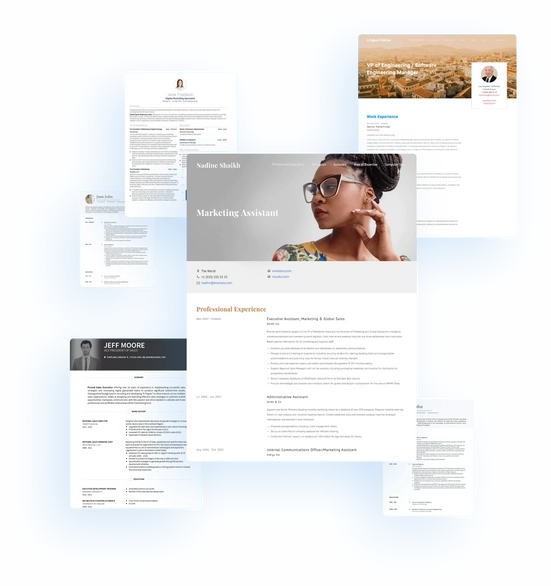
What is the Canadian Resume Format?
A Canadian resume format is a structured way of showcasing your contact information, past work experience, skills, education and important information that will help a hiring manager assess your suitability for the job. A typical Canadian resume uses either of these formats: reverse chronological, function, or combination.
The 3 Popular Canadian Resume Formats
The top 3 Canadian resume formats are:
- Reverse chronological resume format
- Functional resume format
- Combination resume format
These are the resume formats that are popular across Canada. We saw chronological and functional resumes top the choice while combination resume format was the third choice.
Surprisingly, job seekers in Toronto preferred a reverse chronological resume over any other resume format.
Let’s now take a look at these Canadian resume format examples.
Chronological Canadian Resume Format Example
Here’s what a Canadian resume built using the chronological resume format would look like:
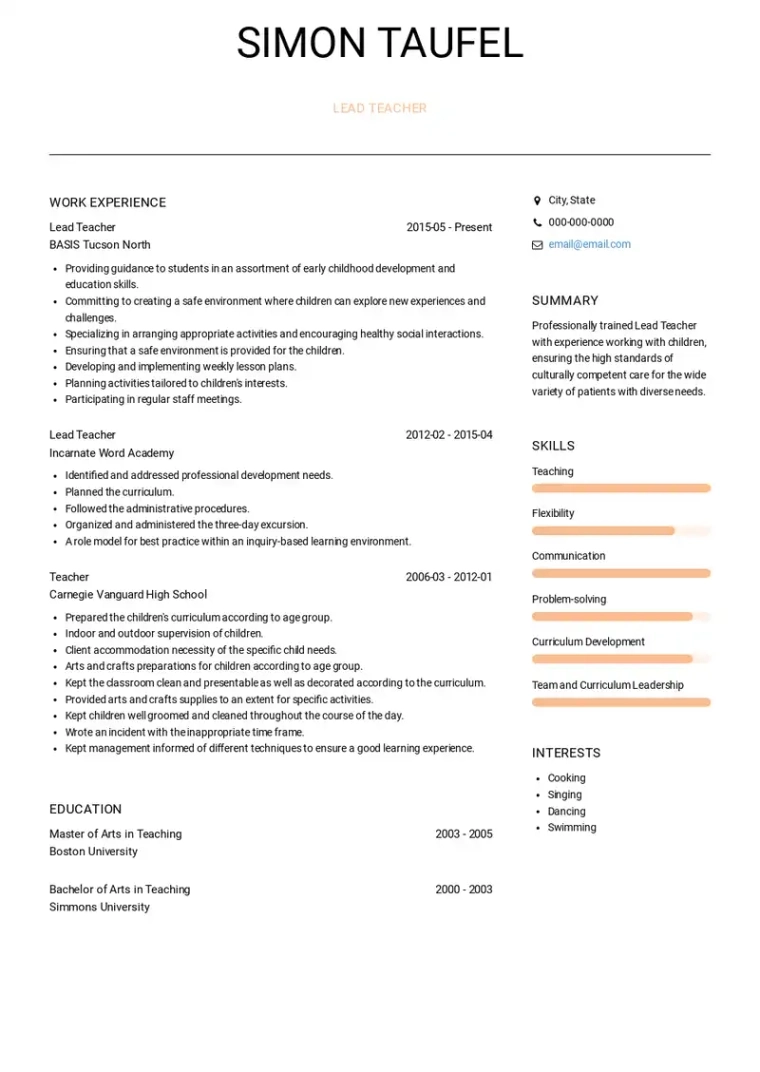
Is a Reverse Chronological Format Right for Your Canadian Resume?
Reverse chronological resume right for you if:
- You have relevant work experience to highlight.
- You aren’t changing careers (e.g. software engineer applying for a marketing position)
- Your total work experience is less than 20 years.
Functional Canadian Resume Format Example
Here’s what a Canadian resume built using the functional resume format would look like:
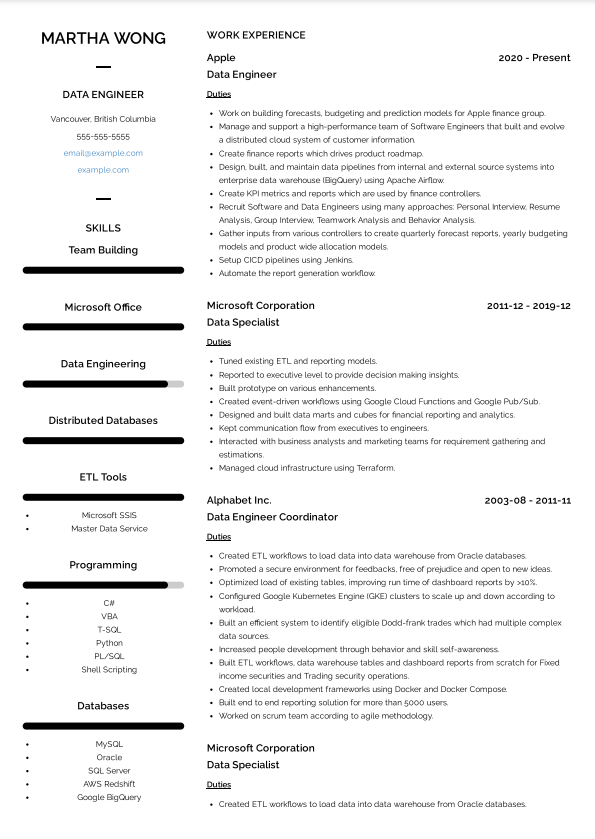
Is a Functional Format Right for Your Canadian Resume?
Functional resume right for you if:
- You have to explain how your skills are relevant to the advertised position
- You wish to highlight your outstanding skills and achievements
- If you wish to lead with your skills instead of experience
Combination Canadian Resume Format Example
Here’s what a Canadian resume built using the combination resume format would look like:
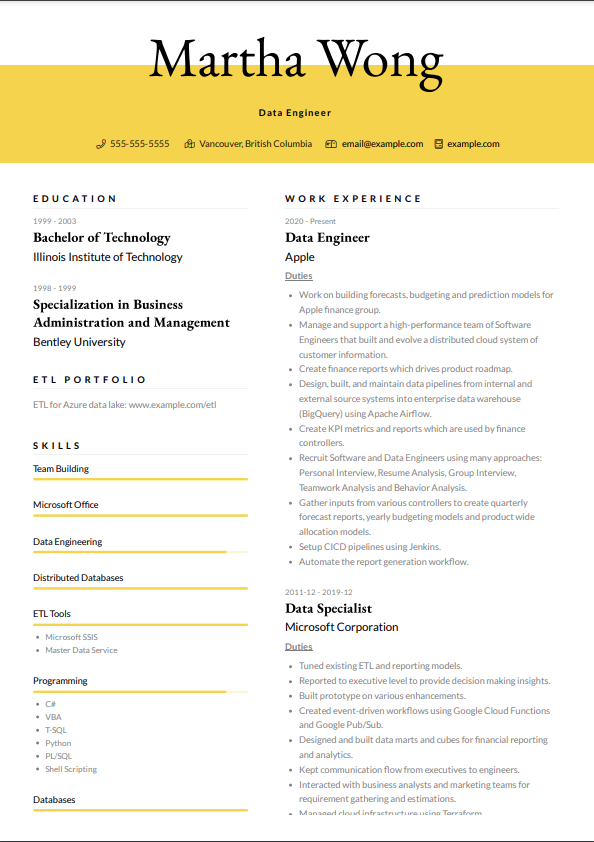
Is a Combination Format Right for Your Canadian Resume?
Combination resume right for you if:
- If you are right a resume with more than 15 years of experience
- You’ve worked across a range of companies, industries of jobs
- You wish to highlight your overall qualifications in terms of skills and expertise over work experience
Combination resumes are not that popular across Canada though, so if you are planning on using one - exercise caution. Make sure to revisit your resume to ensure it conveys your skills in a meaningful way.
Let's now address the next item on our list - a good Canadian resume template.
Canadian Resume Template
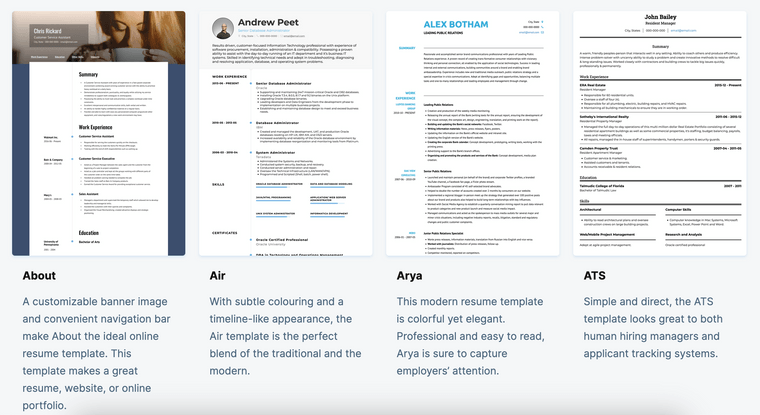
If you are looking for a few more format specific resume templates, here are a few that are just perfect for the popular Canadian resume formats.
Reverse Chronological Canadian Resume Template
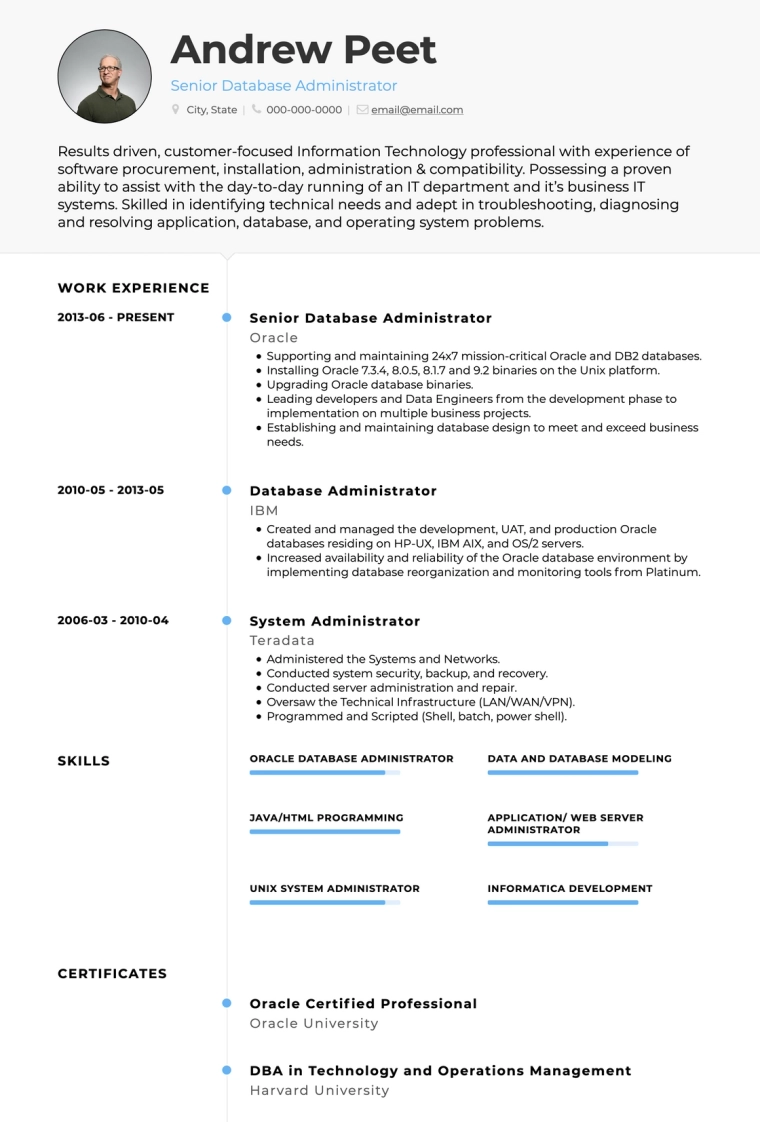
Canadian Resume Template with Functional Resume Format
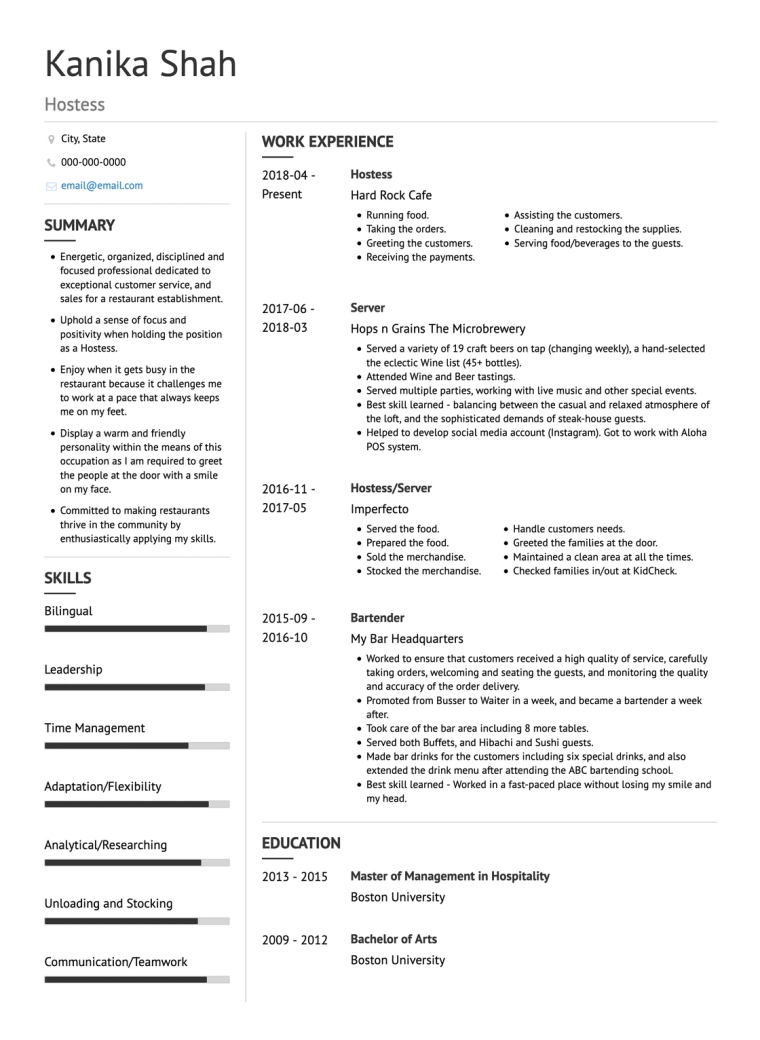
Canadian Resume Template with Combination Resume Format
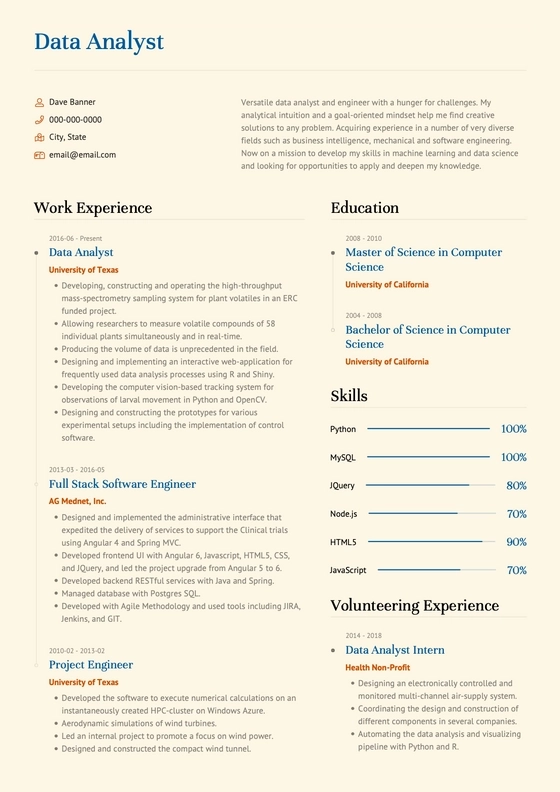
Alright, you now know what a typical Canadian-style resume looks like and what templates to use. But, what should you add to it? Let’s cover that now.
How to Write a Canadian Resume?
After helping hundreds of thousands of job seekers optimize their Canadian resumes, we can assure you that the best way to write a Canadian resume is:
- Based on your experience and skills, select the right resume format.
- Pick a resume template that supports your important resume sections.
- Add your full name, contact information, and link out to Linkedin or relevant portfolio
- Write a resume summary/objective of two lines.
- Write your work, volunteer, or project experience following the STAR method.
- List your top skills - make sure to customize them based on the job ad.
- List your education in a separate section.
If you follow these 7 points listed above, you can easily beat 9/10 applicants for the job.
But, let’s not leave it here. Let’s show you how you can go from the top 10% to the top 1% of applicants.
To be the best, you’ll have to write each section of your Canadian resume with care. This is where the top 1% of applicants differentiate themselves.
To help you craft your resume’s section with ease, we created these templates that you can use and write those sections. You can find them below.
Work Experience Format for a Canadian Resume
[Job title] [Company name, City, Province] [Date started] - [Date ended]
- [Task 1] [Situatuation faced and the solution used]
- [Task 2] [Situatuation faced and the solution used]
- [Task 3] [Situatuation faced and the solution used]
- [Task 4] [Situatuation faced and the solution used]
Example of Listing Canadian Work Experience on Resume
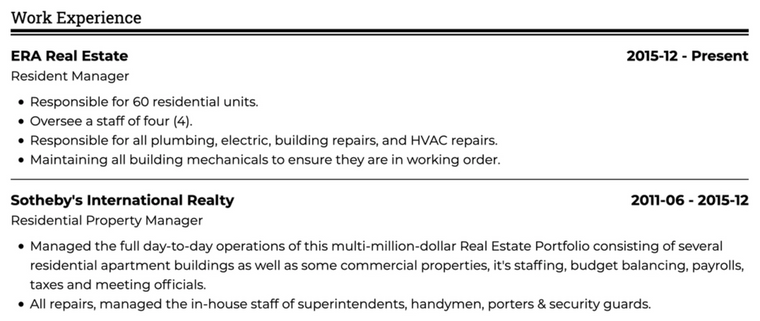
Important things to keep in mind when using this Canadian resume’s work experience template:
- Ideal to keep each task/achievement to one line
- Using simpler words would help as it improves readability
- Customize your work experience based on the job ad
Canadian Resume Summary Format
"[Job title] with [number of years] experience of [top 2-3 skills] across [industries]. Achieved [top achievement]. Expert at [X], [Y], and [Z]."
You can additionally list the following within your resume summary too:
- Any awards that you’ve received
- Any passions you have
A simple glance by a Canadian hiring manager would provide them with all the right information they need to continue reading further.
You can also adapt this Canadian resume summary format to write an objective too.
Note : If you are writing your Canadian resume for a career transition or your first job - write an objective instead of a summary.
Objectives help connect your skills and experience to the job that you are applying for.
Format to List Skills on Your Canadian Resume
To list skills on your Canadian resume, try the format provided below: Technical Skills
Example of How to List Skills on a Canadian Resume
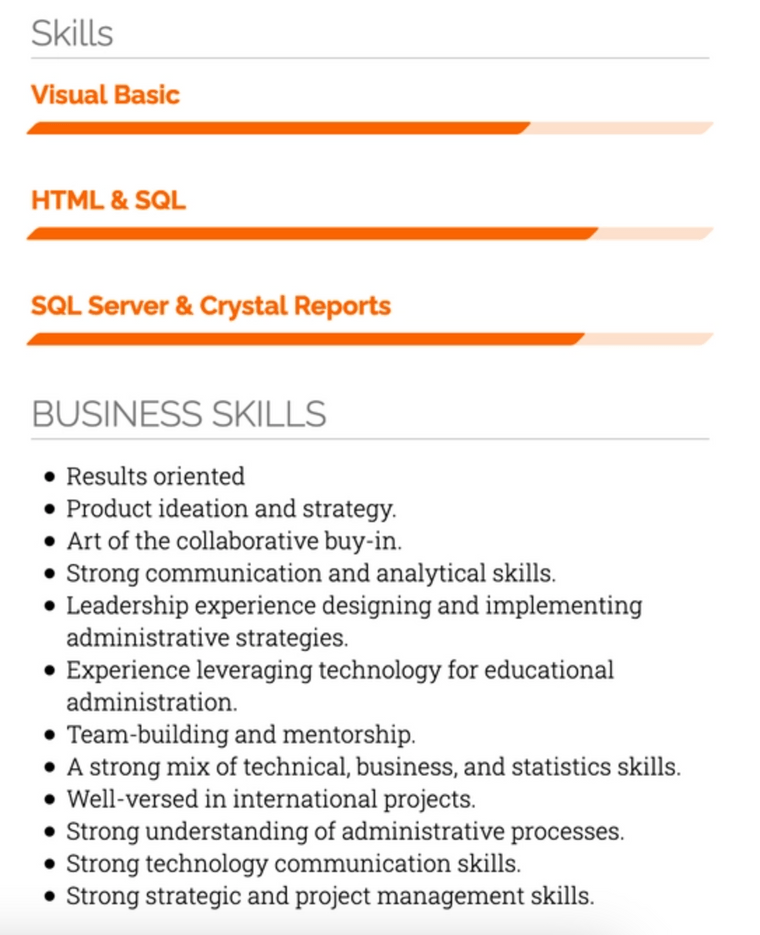
Make sure to list skills that are relevant to the role that you are applying for and are impactful.
Let’s now look at 10 Canadian Resume Examples. If you wish to access resume examples specific to your job title, click the button below and sign-up.
10 Canadian Resume Examples
Canadian resume example for data engineering.
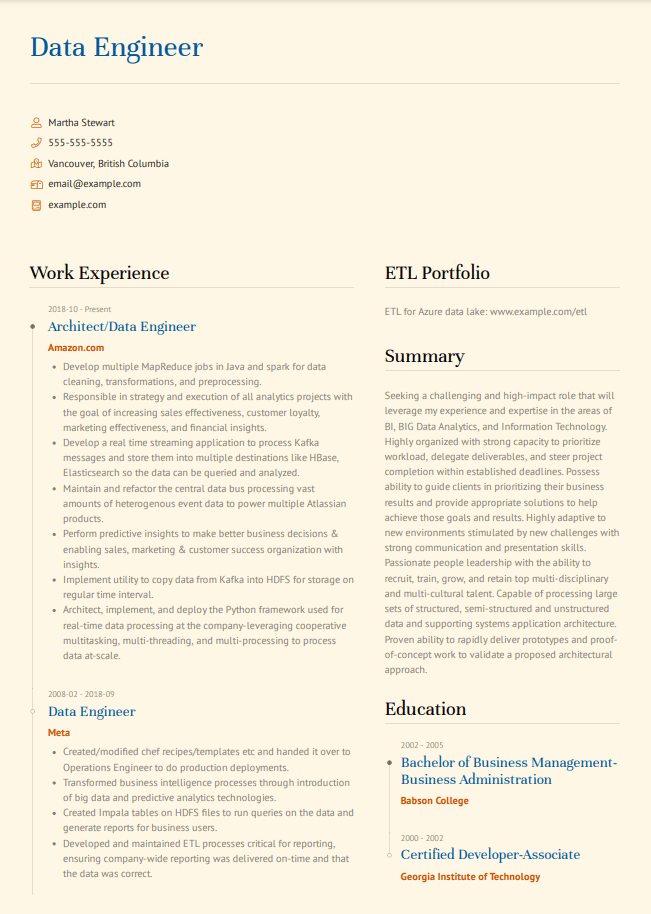
Sales Canadian Resume Example
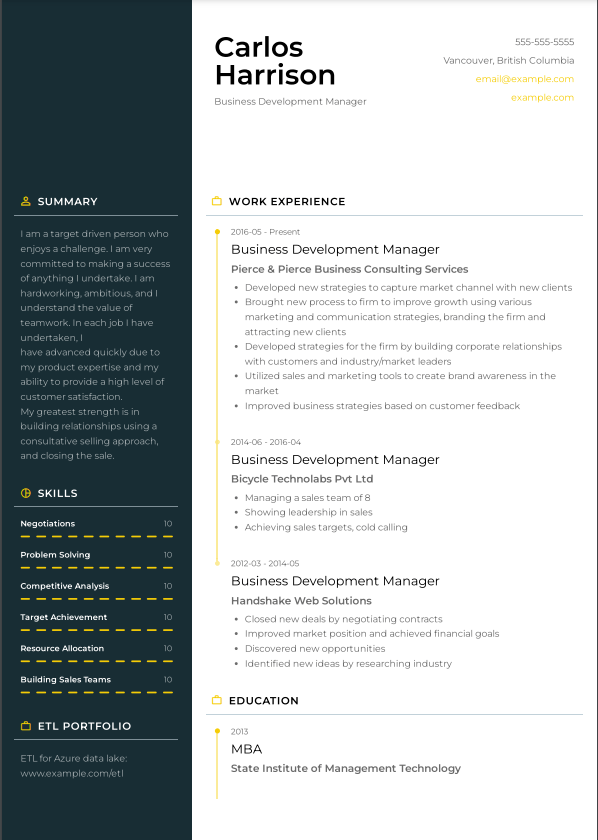
Canadian Resume Example for Accountants
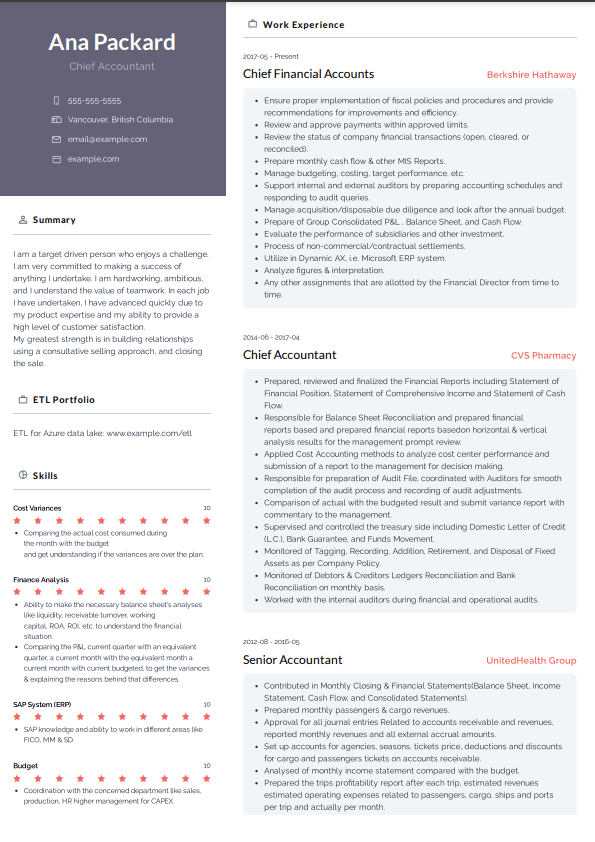
Writer Resume Example for Canada
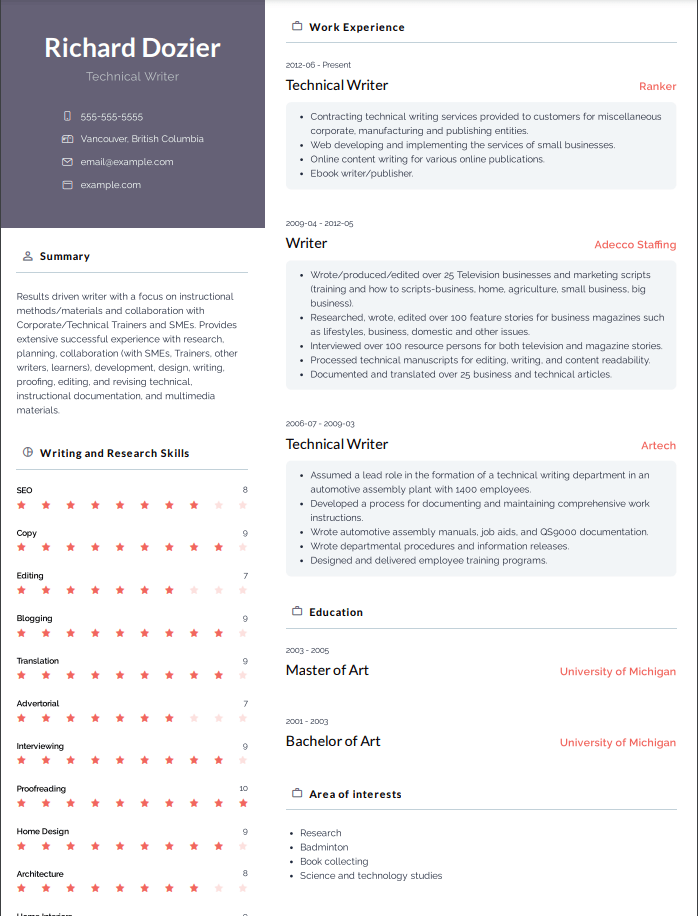
Canadian Resume Example for Executives
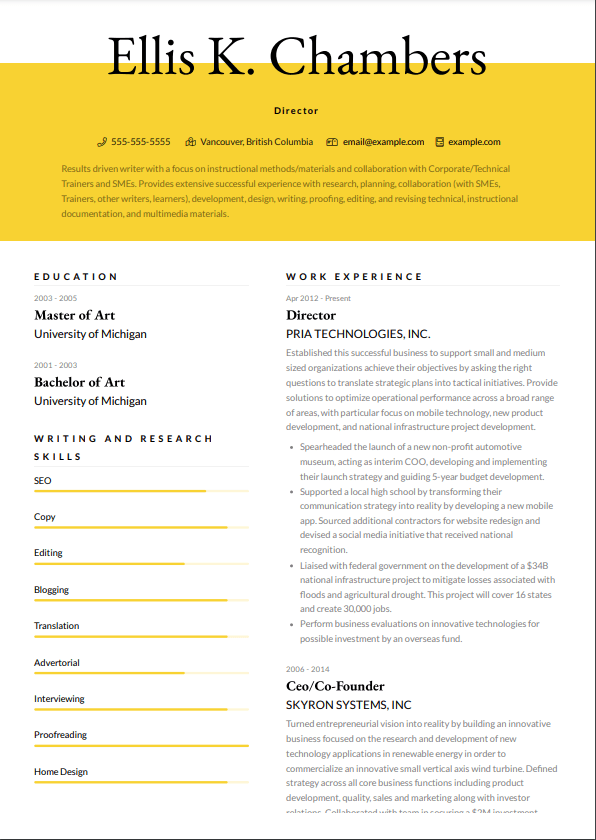
Canadian Software Engineering Resume Example
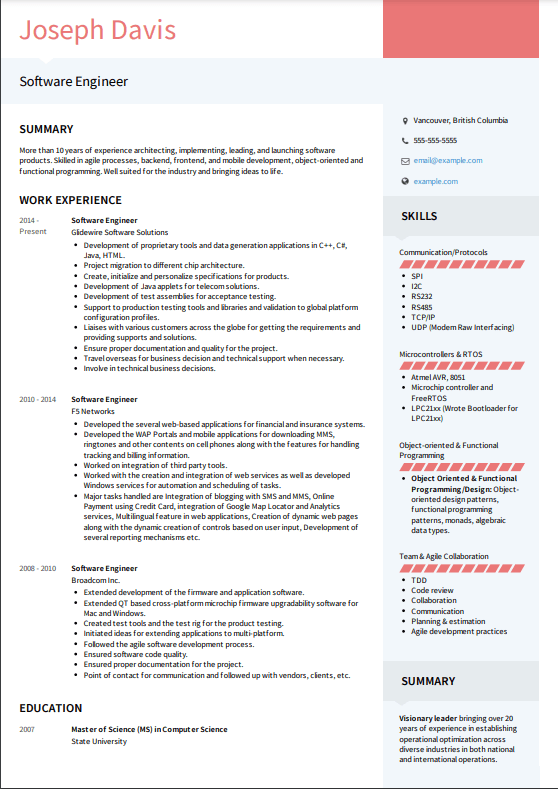
Canadian Designer Resume Example
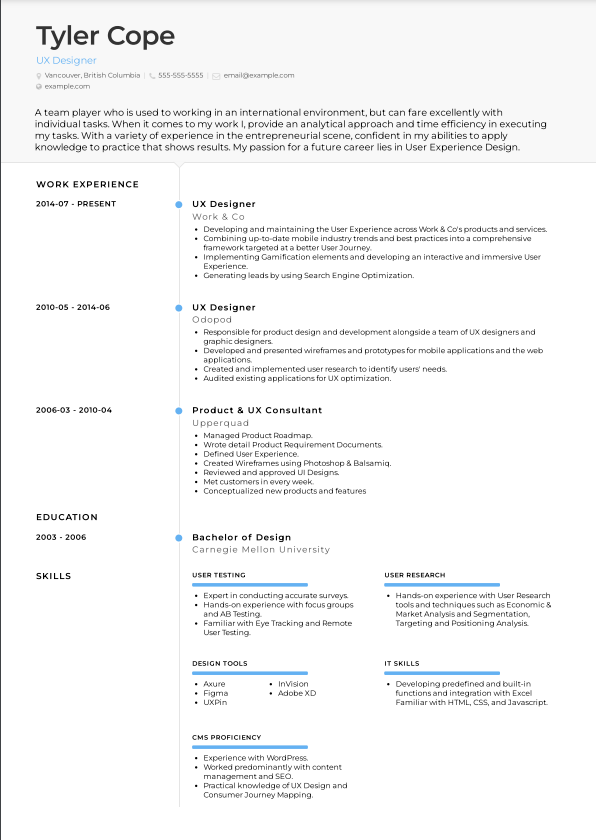
Project Management Resume for Canada
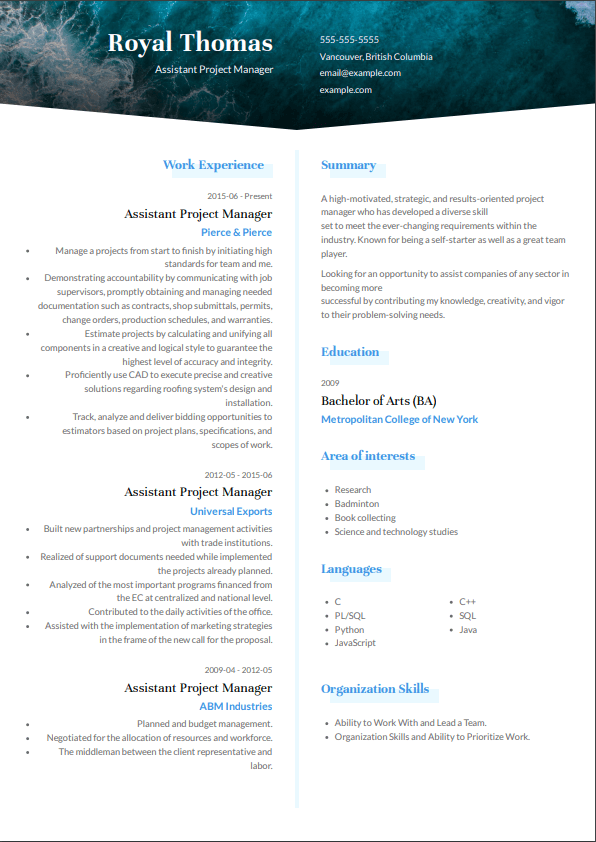
Retail Canadian Resume Example
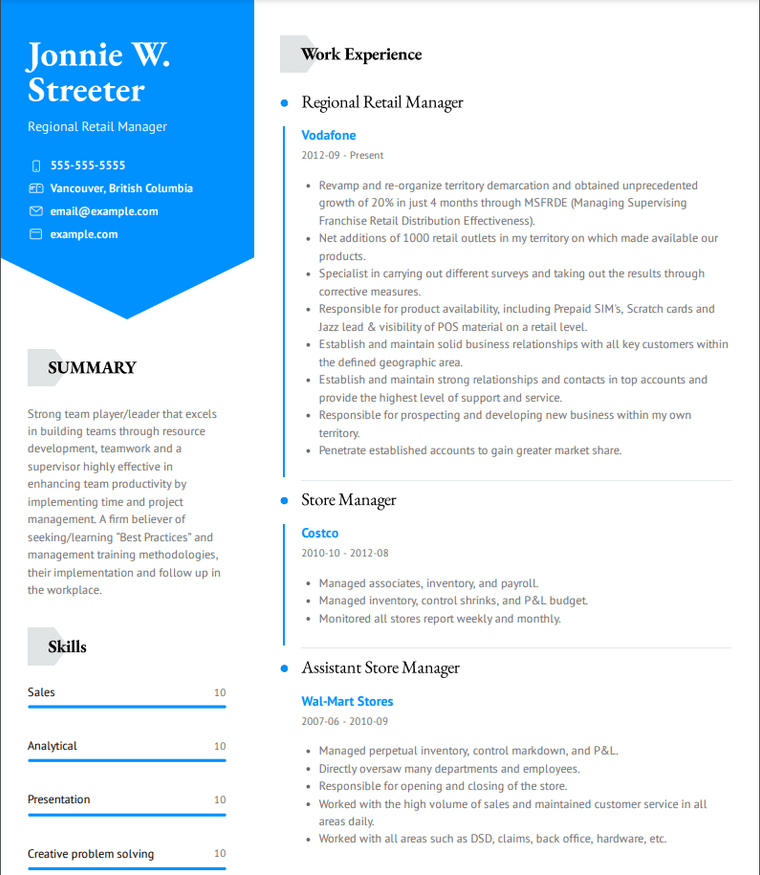
Canadian Resume Example for Teachers
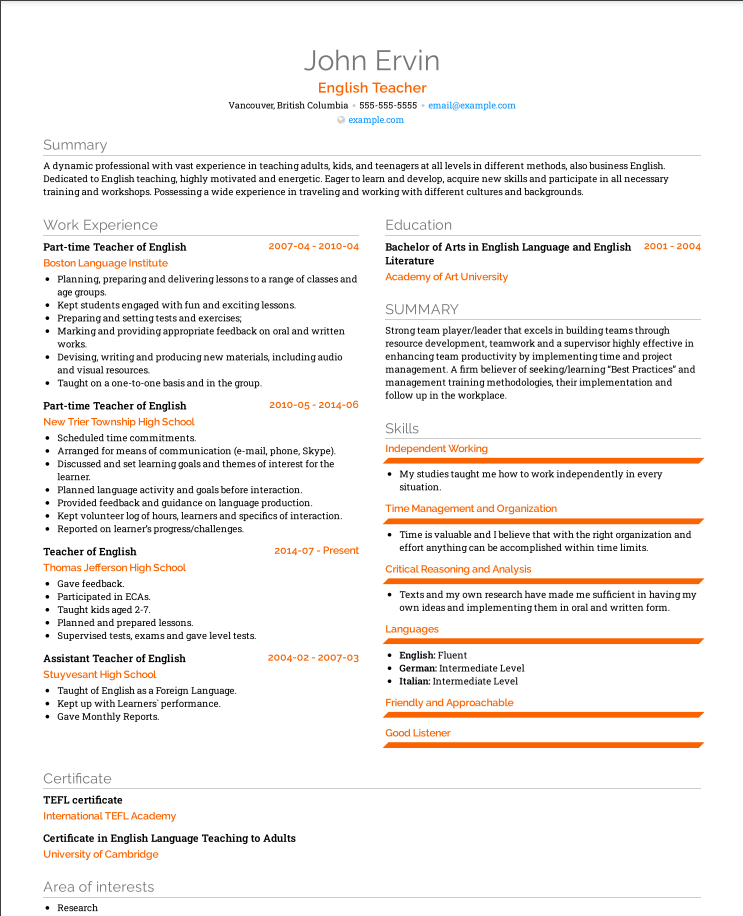
Now that you understand how to create a Canadian resume, let’s clear some frequently asked questions.
Is a Canadian Resume Format Different from An American Resume Format?
No, Canadian resumes are extremely similar to American resumes.
Applying for Jobs, but Getting no responses? Maybe, it’s your resume!
How to Convert my Indian Resume to a Canadian Resume?
To convert your Indian resume to a Canadian resume, follow these steps:
- Customize your resume to ensure it is relevant to the job you’re trying to land.
- Remove any hard English words (e.g. esteemed), instead, use easy-to-read words.
- Remove photo, nationality, race, gender, and your full address. Those aren’t required in Canada.
- Follow the STAR method while writing your work experience.
- While listing your certifications, make sure they are recognized by Canadian employers.
- Add a short summary or objective at the top of your resume. Make sure it isn’t more than two lines and is very impactful.
- While listing your education be careful not to list CGPA, instead standardize your scores to a GPA scale and list it. GPAs greater than 3.7 look good, else it is better to not list them.
- While listing your contact information, make sure to list the Canadian city and province along with a Canadian phone number. +91 numbers won’t help here.
- Finally, resumes in India generally appear to be more than two pages. Make sure yours isn’t more than two pages. Ideal to have a relevant resume of one page.
Once you follow these additional instructions and follow our general guidelines at the top - it should be easy to transform your Indian resume into a Canadian resume.
How to Convert my European CV to Canadian Resume?
To change your European CV to a Canadian resume, follow these steps:
- While European CVs differ from country to country, some common things to remove from your resume - birthdate, citizenship, photo, etc.
- Hobbies constantly surface in entry-level EU CVs, we recommend that you remove them when applying for Canadian jobs.
- Select one of the following Canadian resume formats: chronological, functional, or combination.
- Make sure you have a summary/objective, work history, skills, education, and certifications section (if any).
- Follow the STAR method while writing your resume. It is a must!
- Avoid adding paragraphs as it would reduce the readability of your resume.
- Scan your resume for grammatical errors.
Checkout our other international resume guides here.
How Long Should my Canadian Resume be?
A rule of thumb - for students and professionals with less than 15 years of experience the resume should be one page or a maximum of two pages. For Canadian job seekers with more than 15 years of relevant experience, more than two pages is acceptable.
Should I Add a Photo to my Canadian Resume?
No, avoid adding a Photo while creating a Canadian resume.
Is it a Good Idea to List Marital Status on a Resume for Canada?
No Canadian employer would ever ask for this information as a part of their recruitment process. So, we would recommend that you don’t list marital status on your resume.
Should I List My Nationality on a Canadian Resume?
Legally, no Canadian employer can ask you about your nationality. So, we would not recommend that you list it on your resume.
Can I Lie on My Canadian Resume?
Don’t lie on your Canadian resume. With background checks, reference checks, etc being so common, you’ll be caught. Even a small-innocent lie like a difference of month or days in starting dates of your employment could lead to rejection.
How to Write a Canadian Resume with No Canadian Experience?
- Focus on Transferable Skills : Highlight skills from your previous jobs that are relevant to the position you're applying for.
- Canadianize Your Resume : Use Canadian terminology and metrics where applicable.
- Include Volunteer Work and Internships : These can showcase your commitment and experience.
- Emphasize Education : Highlight your academic achievements and any relevant coursework.
- Tailor Your Resume : Customize your resume for each job application to match the job requirements.
Do I need a Cover Letter With my Canadian Resume?
Yes, including a cover letter with your Canadian resume is highly recommended because it allows you to introduce yourself, highlight key qualifications, and demonstrate your enthusiasm for the role and company. A cover letter also provides an opportunity to personalize your application by tailoring it to the specific job and employer, making you stand out among other applicants.
Should I Save my Canadian Resume as .Docx or .PDF Format?
You should save your Canadian resume as a PDF format because it ensures that the formatting remains consistent across different devices and software, presents a more polished and professional appearance, and is the preferred format for most employers due to its ease of use and compatibility.
Copyright © 2024 Workstory Inc.
Select Your Language:

Canadian Resume Format: Complete Guide (2023)
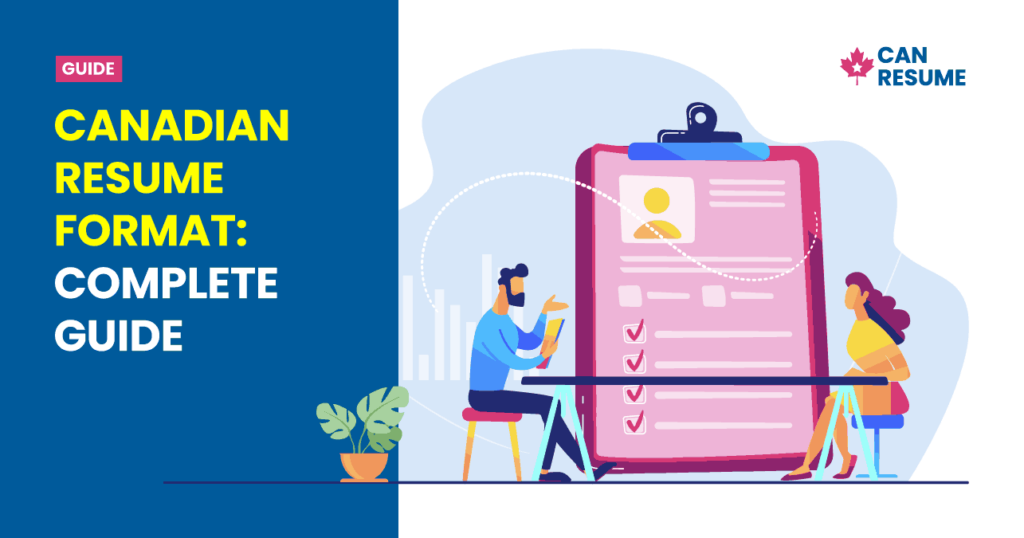
The Canadian job market has its own set of standards, and therefore, it is crucial to tailor your resume accordingly. It is common for job seekers to wonder how their resume should be formatted according to Canadian standards.
In this article, we will explore the key components of a Canadian resume format , including the preferred length, format, and content. We will also provide you with expert tips and examples to help you create a winning resume that will catch the attention of Canadian employers.
Whether you are a recent graduate or an experienced professional, this guide will help you tailor your resume to the Canadian job market and increase your chances of landing your dream job.
How is the Canadian Resume Format Different from Other Formats?
What is the standard page size for a resume in canada, 9. references, which format is best suited for you, understanding the canadian resume format, what is a canadian resume.
A Canadian resume is a document that job seekers use to apply for employment in Canada. It is a summary of the applicant’s work experience, education, skills, and other relevant information.
Canadian resumes can be in either chronological or functional format . Chronological resumes list work experience in reverse-chronological order, starting with the most recent job. Functional resumes focus on skills and experience rather than work history. We will discuss them in detail later.
Why is the Canadian Resume Format Important?
The Canadian resume format is important because it helps job seekers present their qualifications in a way that is clear and easy to read for Canadian employers.
Since Canadian employers receive many resumes for each job posting, it is important for job seekers to make their resumes stand out. By using the Canadian resume format, job seekers can ensure that their resume meets Canadian standards and is more likely to be considered by employers.
While the Canadian resume format is generally similar to other formats used in North America, such as the American resume format, there are a few key differences.
- For instance, Canadian resumes often include a section on language proficiency , as bilingualism (especially knowledge of French) is highly valued in Canada.
- Canadian resumes also often include a summary or objective section at the beginning of the resume, which is not common in other formats.
- Canadian resumes may include a section on professional development or training . This highlights any relevant courses, seminars, or certifications that the applicant has completed.
- Another key difference between Canadian resumes and some Asian countries is that Canadian resumes normally do not include personal information such as the job seeker’s age, marital status, and nationality. Photos are also avoided in most cases unless your looks are important for your profession.
- Canadian resumes typically include contact information such as the applicant’s address, phone number, and email at the top of the document. However, in some countries, this information is only added to a cover letter or given at the end of the document.
- Finally, Canadian resumes may use British English spelling and terminology, which differs slightly from American English.
Canadian Resume Length
The recommended length of a resume in Canada is typically one to two pages , depending on the individual’s work history and experience. For those with a few years of experience, a one-page resume may suffice, while those with more experience may require a two-page resume. Three pages may be acceptable if you have more than 10 years of experience.
Canada Government’s Job Bank website also recommends limiting your resume to two pages.
However, it’s important to prioritize the content of the resume over its length . Focus on effectively highlighting your skills, experience, and education to make a strong impression on potential employers.
How long is a resume in Canada?
It is typically recommended that you limit your resume in Canada to two pages. In the case of a person without much experience, a single page should be sufficient.
Canadian resumes are typically letter-sized (8.5 x 11 inches, 22 x 28 cm), containing one or two pages of information.
Canadian resumes also use standard margins of one inch on all sides and left-aligned text for easy reading.
Key Components of a Canadian Resume
A Canadian-style resume typically includes several sections that provide a comprehensive overview of the applicant’s qualifications and experiences . These sections are crucial in making a strong first impression with potential employers. Here are the key components of a Canadian resume:
1. Resume Header
The resume header typically includes the applicant’s name, contact information, and a professional title. The professional title should be relevant to the job applied for and should showcase the applicant’s skills and experience.
The contact information section should include the applicant’s address, phone number, and email address. It is essential to ensure that all the information provided is accurate and up-to-date. A professional email address is recommended, and it is advisable to avoid using personal email addresses.
2. Resume Summary
The resume summary is a brief statement that highlights the applicant’s skills, experiences, and career goals. It is recommended to keep the summary concise and focused on the job applied for. The summary should be written in a way that captures the employer’s attention and encourages them to read further.
3. Work Experience
The work experience section should include the applicant’s previous work experience, including the job title, company name, dates of employment, and job responsibilities. It is essential to highlight the achievements and accomplishments in each role and quantify them wherever possible.
4. Education
The education section should include the applicant’s educational qualifications, including the degree, school name, and dates of attendance. It is recommended to include any relevant coursework, academic achievements, and certifications.
The skills section should include the applicant’s relevant skills, including technical, soft, and transferable skills. It is recommended to tailor the skills section to the job applied for and highlight the skills that are most relevant to the position.
6. Achievements
The achievements section should highlight the applicant’s accomplishments, including awards, recognition, and other notable achievements. It is recommended to quantify achievements wherever possible and tailor them to the job applied for.
7. Volunteer Experience
The volunteer experience section should include any relevant volunteer work, including the organization name, dates of volunteering, and job responsibilities. It is recommended to highlight any transferable skills gained through volunteer work.
8. Publications
The publications section should include any relevant publications, including books, articles, and research papers. It is recommended to highlight the publication’s relevance to the job applied for and include any relevant details, such as co-authors and publication dates. If you don’t have anything to show or it is irrelevant to the job you are applying for, you can skip this.
The references section should include the applicant’s professional references, including their name, job title, company name, phone number, and email address. It is recommended to ask for permission before including someone as a reference and to inform them when they are contacted by an employer.
Types of Canadian Resume Formats
Canadian resumes come in two main formats: chronological and functional . Each format has its own advantages and disadvantages, and the choice ultimately depends on the job seeker’s experience and career goals.
1. Chronological Resume
A chronological resume is the most common type of resume used in Canada.
It lists the job seeker’s work experience in reverse chronological order, starting with the most recent job and working backwards. This format is best suited to job seekers who have a consistent work history and want to highlight their career progression. This is also more suited for someone who doesn’t have career gaps.
Some tips for formatting a chronological resume include:
- Keep the resume concise and relevant, focusing on the most important details.
- Use bullet points to highlight accomplishments and responsibilities.
- Include relevant keywords to help the resume get past applicant tracking systems (ATS).
2. Functional Resume
A functional resume focuses on the job seeker’s skills and abilities, rather than their work history. This format is best suited to job seekers who are changing careers, have gaps in their work history, or have limited work experience .
Some tips for formatting a functional resume include:
- Highlight skills and achievements that are relevant to the job.
- Use bullet points to organize information and make it easy to read.
- Include a summary section at the top of the resume that highlights the job seeker’s key skills and qualifications.
The choice of resume format depends on the job seeker’s experience, career goals, and job requirements.
- If you are someone with a consistent employment history and no career gaps, a chronological format would be the best for you.
- If you are a fresher, or someone changing careers, or have career gaps, a functional resume would be more suited.
Job seekers should choose a format that highlights their strengths and accomplishments, and makes it easy for employers to see why they are the best fit for the job.
When creating a Canadian resume, it is essential to have a well-structured resume as it is the first impression that a potential employer has of you. Employers receive hundreds of resumes, and therefore, a lengthy resume with irrelevant information may not get the attention it deserves.
A well-structured Canadian resume should have a clear and concise summary or objective, work experience, education, skills, and additional sections, if necessary. By following the Canadian resume format, job seekers increase their chances of getting noticed by potential employers.
Related Articles
- Canada Cover Letter Format And Samples
- How To Create ATS Friendly Resume For Canada
- Guide To Canadian Resume Format
- Difference Between CV and Resume in Canada
- How To Write A Summary Statement For A Canadian Resume
- 300+ Action Words For Canadian Resume
Start typing and press enter to search
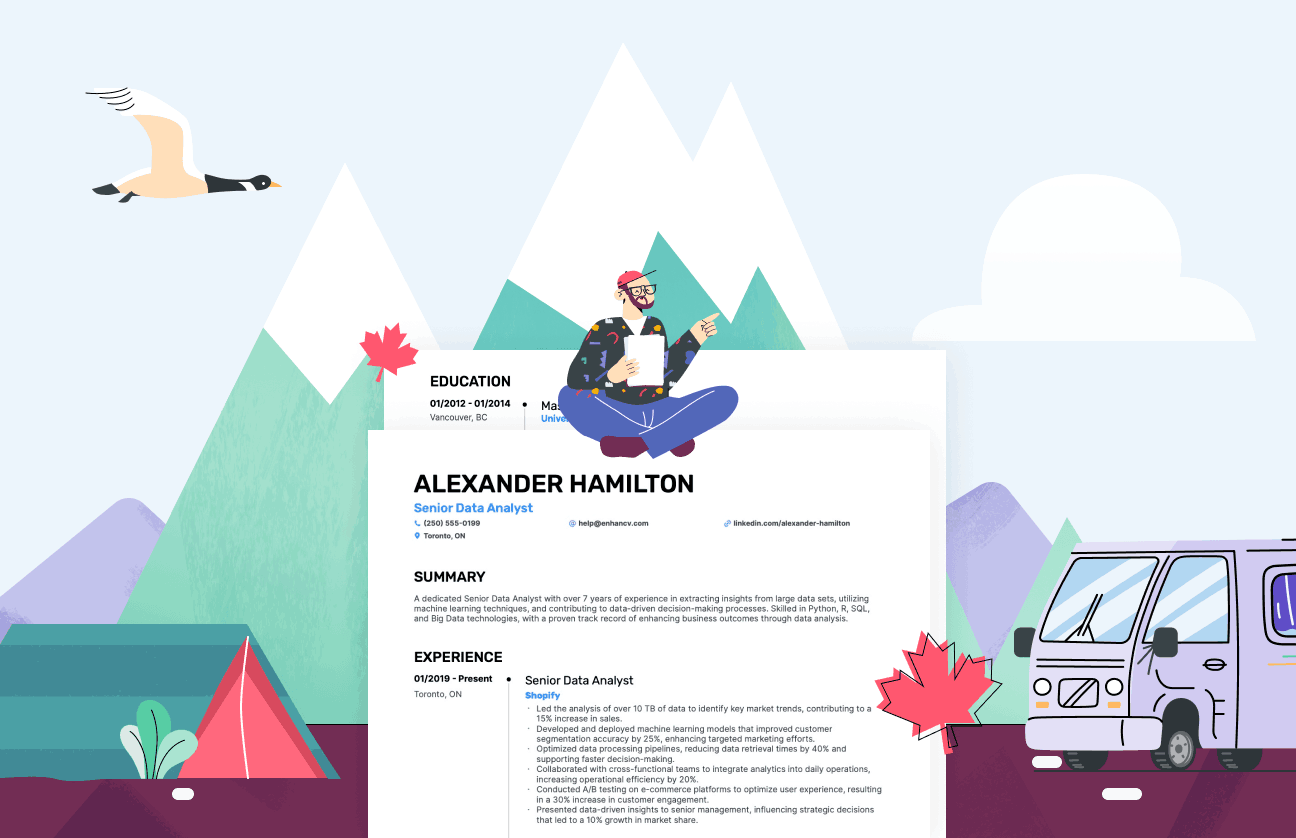
Canadian Resume Format & How-to Guide for 2024
In This Guide:
Canadian resume template, what is the canadian resume format, what is the difference between a canadian and an american (us) resume, what is the difference between a canadian resume and a european cv, how to write a canadian resume, faq about canadian resumes, key takeaways.

Canada plans to invite 1.45 million new permanent residents by 2025 to address labor shortages and an aging population. This move not only aims to strengthen the workforce and ensure immigrant skills meet job demands but also addresses challenges newcomers face in securing appropriate employment.
The country offers a unique blend of American and European characteristics, and this extends to its job application process, especially when it comes to resumes. Understanding the Canadian resume format is crucial whether you're applying for a job within the country for the first time as a foreigner, or you're a Canadian looking to refine your resume writing skills.
But how does a resume tailored for Canada differ from an American one? This guide provides all the details on what makes a Canadian resume unique, alongside practical advice and examples to help you craft a resume that could open doors to new opportunities in Canada.
Here's what we'll explore:
- The distinct features of Canadian resumes compared to American and European formats;
- A detailed guide on crafting your resume to meet Canadian standards;
- An exploration of frequently asked questions, providing thorough answers and insights;
- Advice for making your Canadian resume stand out to employers.
Plus much more! Let's begin!
Find if your resume passes the Canadian format!
Drop your resume here or choose a file . PDF & DOCX only. Max 2MB file size.
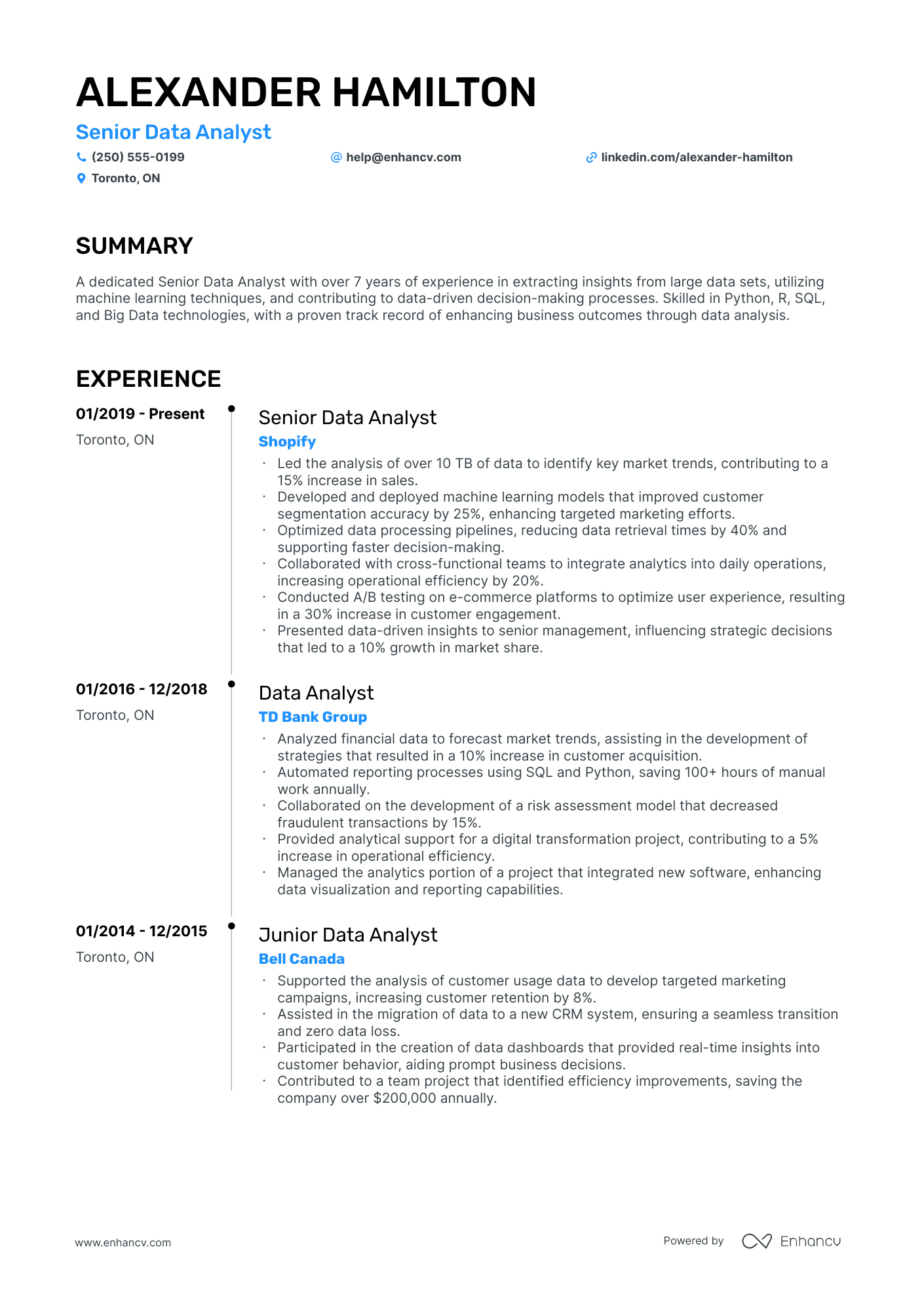
This template has been optimized to meet the demands of the Canadian resume format. It follows a chronological work experience section. Furthermore, it has no photo in the header, something that’s typically frowned upon in Canada.
Last but not least, Enhancv’s Canadian resume template supports a two-page resume format, which is one of the things that sets apart Canadian and US resumes.
The Canadian resume format is a structured approach to presenting your work history and skills relevant to the job you're applying for. It starts with a header section that contains your name, phone number, current location, and email address. If you have a LinkedIn profile , include the URL in your contact information. Many Canadian employers use LinkedIn to research potential candidates. Following the header, you need to put either a summary or objective to give a snapshot of your career goals and strengths. Next, the resume details your work history, education, and skills. Personal details like marital status and photos are not included, allowing the focus to remain on your expertise.
Making a resume for Canada is similar to the United States but for a few important differences. Both countries use resumes more than CVs, and they usually look alike. Yet, spelling matters a lot in Canada. Though Canada uses English, it also embraces French, affecting some English spellings. To make sure your resume fits Canadian preferences, follow these tips:
- Use Canadian spellings , like " behaviour " and " neighbour ," and prefer " theatre ," " labour ," and " defence ."
- Apply the metric system for measurements, showing familiarity with Canada's standards if applicable. For example, if you worked in distribution, you could mention “leading a team that distributed goods across a 300-kilometer area."
- Write dates in the DD/MM/YYYY format, which is common in Canada.
- Include graphic designs in your resume only if you look for a job as a graphic designer. Typically, Canadians don't include these elements when applying for a new position.
- Employ the services of the Canadian Information Centre for International Credentials to understand the Canadian equivalence of your credentials. Taking this step can help push your job search forward, yet it doesn't secure a job offer.
These small but crucial adjustments show you're ready to work smoothly in Canada. They show your ability to adapt and pay attention to local details, which is appealing to Canadian employers.
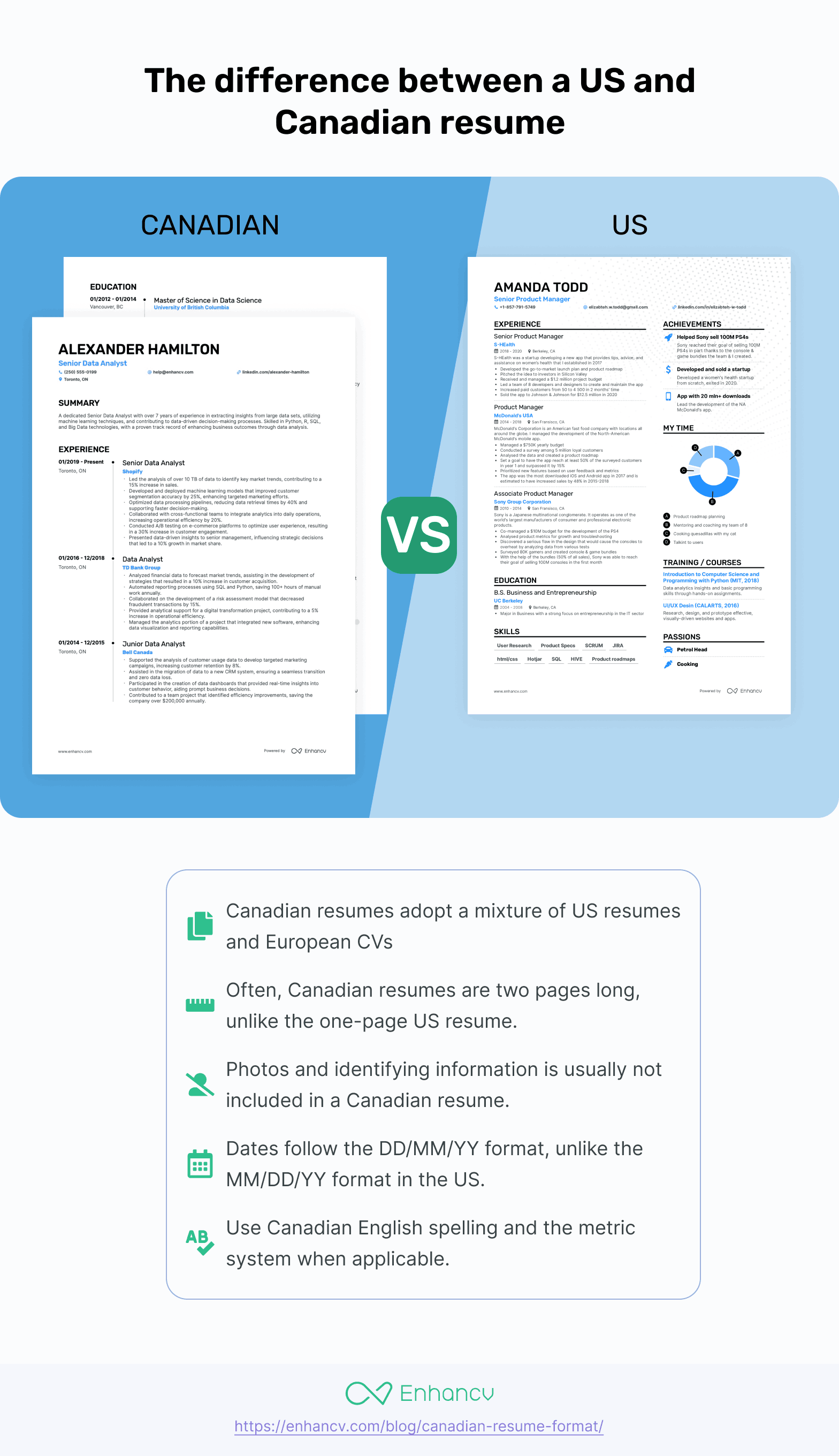
The Canadian resume and the European CV serve as key tools in job applications, but they follow different conventions that reflect the job market and cultural expectations of their respective regions. The Canadian resume format is streamlined and job-focused, typically extending to a maximum of two pages and emphasizing the candidate's most relevant experiences and skills for the specific position.
Moreover, in Canada, when we talk about a CV, we're referring to a very detailed document mostly used in academic settings, not for regular job applications. These CVs are pretty lengthy, going from two to ten pages, and they cover everything from your work history to your projects and any papers you've published.
European resumes, commonly called CVs in the Old Continent, tend to be more detailed compared to Canadian resumes. They include high school education and grades, regardless of higher educational achievements. This level of detail is unnecessary in Canada, where the focus shifts to post-secondary education and adequate work experience .
Another big difference is the inclusion of personal information. In some European countries, including a photo on your resume is common and often expected by employers.
Including photos on your resume is not endorsed in Canada. Personal details such as date of birth, nationality, or other information that could potentially lead to discrimination are omitted in Canadian resumes.
The goal is to ensure a fair evaluation process, focusing solely on professional qualifications and experiences.
Believe it or not, the Canadian resume is pretty similar to an American. However while the format is similar, the devil is in the details.
When looking for a job in Canada, picking the right resume format is key because it really affects your chances of success. If you've been working for more than ten years, think about using a reverse chronological resume . This format lists your jobs from newest to oldest, making it easy to see how you've moved up in your career. It's a good way to show your experience in a clear way that employers like, especially in Canada.
In addition to the format, you also need to consider the template. It's important to choose a professionally designed resume template which can enhance the readability of your resume and create a positive first impression with hiring managers. After you've selected your template, the next step is organizing your Canadian resume.
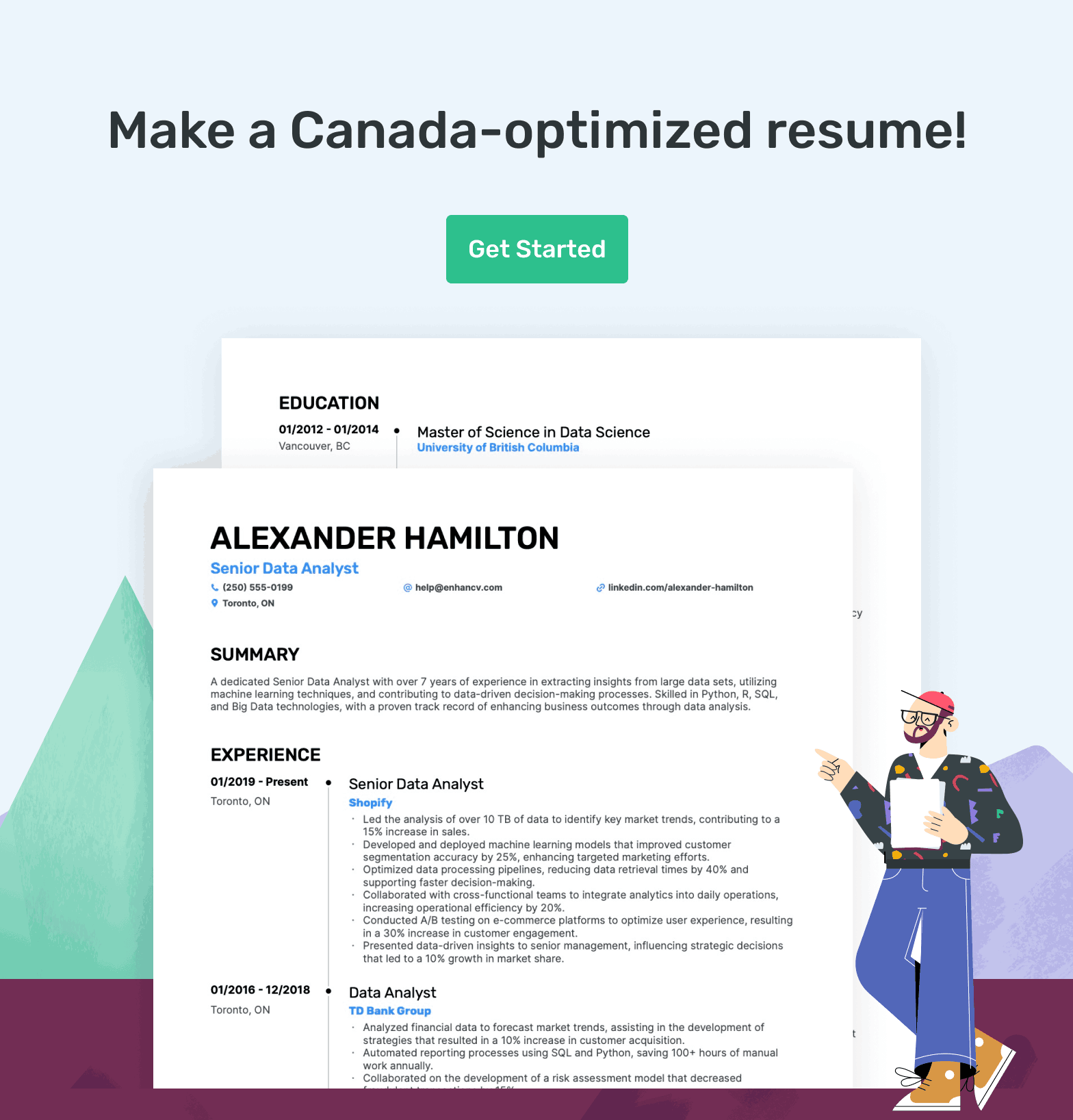
When creating your Canadian resume, start with a well-organized header that grabs attention. Include essential information like your name, job title, phone number, professional email, and LinkedIn link. Make sure your name matches what's on your professional records and online profiles to make it easy for recruiters to find you.
Moreover, it would be better to use a professional email provider like Gmail or Outlook. Mention the job you're applying for, not your current position, to align your resume with the job listing. Just listing your city is enough for the location, especially if you're applying for jobs in different places.
Finally, when you include links to your LinkedIn or portfolio, make sure they're up-to-date and match your resume.
A clear and concise header, focusing on these key elements, will demonstrate you're a strong candidate for the job. Here’s an example:
Jackson Thompson's resume header is thoughtfully organized and offers quick access to his contact and professional information.
Resume summary
Following the header, the career summary section appears, offering a concise overview in no more than five sentences that show your key professional achievements. The professional summary focuses on your main strengths and skills related directly to the position's duties and responsibilities. After reading the information in this section, the recruiter has a better understanding of who you are and what skills and abilities you may bring to the position. Tailor this for every job application to address the company and the position's requirements.
Let’s see an example:
This example shows the applicant's strong expertise in marketing and track record of achievements. Also, it puts the focus on specific skills and growth metrics that are important for Canadian employers.
Work experience
When creating your work experience section list your previous jobs in reverse chronological order, starting with the most recent. Include the job title, company name, location, and dates of employment. Describe your responsibilities, achievements, and contributions using bullet points.
Here’s an example of the structure:
- Begin with the latest job and work backwards, but limit the history to the last 10 to 15 years. Older roles, like a college job, might not interest the hiring manager.
- Lead with the position title , which helps the recruiter assess if your experience aligns with the job requirements.
- Mention the employer's name and its location . For lesser-known companies, a short description might be helpful.
- State the period of employment using the DD/MM/YYYY format , which is concise and clear.
- Describe your responsibilities and accomplishments with 4-6 bullet points for recent roles and 2-3 for previous positions .
Check out the example:
- • Developed and executed a digital marketing strategy that resulted in a 30% increase in website traffic.
- • Managed social media accounts, growing the follower base by 25% in one year.
- • Coordinated with the sales team to create promotional materials that led to a 15% rise in sales.
- • Organized and directed market research studies to inform future marketing strategies.
- • Led a team in implementing innovative email marketing campaigns that boosted lead generation by 20%.
- • Spearheaded the redesign of the company website, improving user engagement metrics by 35%.
- • Established a content marketing plan that increased brand visibility and market penetration.
- • Optimized website content for major search engines, resulting in a top 5 ranking for key terms.
- • Analyzed web analytics to adjust SEO strategies and improve overall website performance.
- • Collaborated with the content creation team to ensure SEO best practices were consistently applied.
- • Assisted in the development and implementation of marketing strategies to enhance brand recognition.
- • Supported the organization of promotional events that led to increased customer engagement.
- • Conducted competitive analysis to inform the marketing team's strategy adjustments.
This example illustrates an effective way to organize your work history when listing multiple previous roles. It emphasizes the importance of conciseness while clearly detailing your responsibilities and successes.
Carefully read the job posting and identify the required qualifications and skills. Take note of particular keywords and phrases used throughout the description to tailor the resume for the specific role.
The educational background is an essential part of your Canadian resume and it comes right after the work experience. Here is the place to mention the degree, diploma, and certifications earned, the name of the institution, the location, and the year of graduation . Begin with your most recent educational achievement and proceed in reverse chronological order, mirroring the format of your work history section. Don't forget to highlight any honors or academic distinctions you've received.
For your Canadian resume, consider specifying this information in the education section:
- State the degree you've earned as your degree title .
- Identify the institution where you received your education as your college or university.
- Include the location of your educational institution .
- Note the year of your graduation or the anticipated graduation year as your completion date.
- Mention a minor study , for instance, "Minor in Digital Media," to demonstrate a broader skill set within the marketing field.
- List any certificates you obtained related to your field of study.
Here's how this section can look:
- • Specialized Coursework: Advanced digital marketing strategies and data-driven marketing decisions
- • Graduated with Honors
- • Minor in Digital Media
- • Core Modules: Marketing principles, consumer behavior, and digital media strategy
This example demonstrates a structured approach to presenting your educational background. It shows how to effectively list degrees, institutions, and relevant coursework, ensuring that your qualifications are easily understood by recruiters in Canada.
You may need to have your documents translated into English, French, or both.
It is generally advised to keep the education section simple, ensuring it doesn't overshadow your skills.
Highlight your key skills relevant to the job. This can include technical skills, software proficiency, language proficiency, and any other abilities that showcase your qualifications for the position.
Skills on your resume are categorized into:
- Soft skills refer to personal qualities and behaviors developed through both life and work experiences. These skills encompass communication, attention to detail, and problem-solving.
- Hard skills stand in contrast as the specific technical know-how or proficiencies gained through education, training endeavors, or direct experience. For instance, in the context of finance, include specialized expertise like advanced Excel functions for financial analysis, familiarity with QuickBooks for accounting tasks, and adeptness in using Bloomberg terminals for market research.
When curating your skills list, focus on those most relevant to the job at hand. For a front-end developer position, for instance, your proficiency in HTML, CSS, JavaScript, and frameworks such as React or Angular is more relevant than an unrelated skill like martial arts. Employers seek skills that make you an ideal fit for their specific needs, rather than a broad array of abilities.
To ensure your resume resonates with the job description, identify the employer's desired skills and make sure to include them in your Canada resume. Aim for a balanced presentation of both soft and hard skills tailored to meet the requirements of a front-end developer role.
Here’s how you might approach it:
When we talk about resume creation, language skills are more than just a mark of education. They're a bridge to diverse cultures and markets, making them vital in the Canadian job market. Adding languages to your Canadian resume shows your ability to communicate across different cultures.
In Canada, where English and French are widely spoken, being bilingual can significantly boost your job prospects. Including languages on your resume , along with your proficiency levels, signals to employers your capacity to adapt and connect in a multicultural setting. This section is crucial, distinguishing you as a candidate well-suited for the dynamic Canadian work culture.
Languages and additional courses both play a crucial role in enhancing your professional profile, so let's see how to present them properly in your Canadian resume.
This is an ideal moment to demonstrate your passion for learning. Include any relevant training, courses, or seminars to underscore your dedication to ongoing professional growth. It signals to employers your commitment to staying updated with industry trends and techniques, enhancing your appeal as a candidate.
Such educational achievements can be especially crucial in fast-changing sectors, evidencing your readiness to tackle contemporary challenges.
Start with your newest qualifications and list them in time order, similar to how you list job experience and education.
Let's go back to our example of Jackson Thompson, the Marketing Specialist, and check what courses would be relevant for him.
Is your resume good enough?
This part of our guide is your go-to resource for addressing frequently asked questions about crafting resumes for the Canadian job market. Learn how to create cover letters, tips for international applicants, and whether to choose PDF or.docx. Let's begin with the very first topic.
How do I navigate the Canadian job market as a foreigner?
Navigating the Canadian job market as a foreigner can certainly be a challenge, but with the right approach, it's definitely manageable. Here's your compass and map to find your way through.
Let's go forth with precise tips.
- Identify the industry you’re educated in and make your resume resonate with Canadian employers by thoroughly researching the Canadian job market .
- Start building your network by participating in career fairs, making connections at professional events, and creating a solid LinkedIn profile to showcase your skills.
- Take on freelance opportunities to gain valuable Canadian experience and integrate yourself into the local professional community.
- Utilize resources such as the Canadian government’s Job Bank and immigrant-serving organizations to find valuable assistance in your job search.
- Demonstrate your readiness to thrive in Canada's diverse workplace by emphasizing your cultural awareness and language skills in English or French.
- Boost your qualifications by taking courses or getting certifications from well-known institutions or companies in your area. If we go back to our example for the Marketing Specialist Jackson Thompson, he should focus on acquiring certifications from renowned companies such as Google and Microsoft as these certifications are globally recognized and respected and would serve as a testament to an overseas candidate's skills and knowledge.
- Tailor your resume with each job description and adapt your application to meet specific employer preferences, including Canadian spelling nuances. Remember, precision, like opting for 'colour' over 'color', demonstrates attention to detail.
- Keep a steady pace and stay resilient in your job search in Canada, and know that finding the right opportunity might take time but your efforts will eventually pay off.
Do I need a cover letter to pair with my resume when applying for a job in Canada?
It's a good idea to include a cover letter with your resume. A cover letter lets you detail how your skills match the job and the company's needs. It helps you make a strong first impression and gives you space not only to demonstrate your enthusiasm about the position but also to present yourself professionally .
Here's some practical advice for your cover letter:
- Ensure your header aligns with your resume by listing your name, surname, job title, Canadian phone number, and professional email. You can also add a LinkedIn profile or personal website to make your application more engaging.
- Address the cover letter properly in your greeting line, using 'Dear [Name]' or 'Dear Mr./Ms. [Surname].' If the name of the hiring manager is unknown, 'Dear [Department] Team' works well. This personal touch shows effort and interest.
- Start your cover letter with a powerful opening sentence that highlights your achievements or unique skills, capturing the hiring manager's attention and setting you apart from other applicants.
- In the body of your cover letter, go beyond your resume to tell a compelling story about your skills and experiences. Showcase how you can contribute to the company's success with examples of leadership, communication, and problem-solving abilities.
- Conclude with a closing paragraph that encourages further dialogue, ensuring you include your signature line.
Open the door to your new job in Canada with our professionally designed cover letter templates . Use our intuitive cover letter builder to make your own for free.
Should I save my Canadian resume as a .docx or a .pdf file?
The PDF format is highly recommended due to its consistent appearance on various devices and operating systems. It preserves your document's design and visuals and eliminates the risk of unintended edits by the recipient.
Job platforms in Canada commonly accept both PDF and Word documents. However, unless specified otherwise in the job posting, opting to submit your resume as a PDF is advisable for preserving its intended presentation.
Include your full name in your document filename to make it memorable (i.e. Jackson-Thompson-Resume.pdf)
Do Canadians say “CV” or “Resume”?
In Canada, the terms "resume" and "CV" (Curriculum Vitae) are both used, but they have different meanings. A resume is usually one or two pages long and shows your skills and experience related to the job you want. It's meant to be quick to read and match the job description. Canadian employers prefer this direct and brief way of showing your capabilities.
On the other hand, a CV is much more detailed and covers your whole career, including education, publications, research, and big achievements. It's mainly used in fields like academia, science, and medicine, where showing the full scope of your work matters a lot. CVs are longer than resumes and can be much more than two pages, based on how much you've done in your career.
What NOT to include in my Canadian resume?
In Canada, your cover letter and resume should not contain personal details such as marital status, religion, gender, age, or sexual orientation. Additionally, unless you're seeking a role in modeling or acting, photos are unnecessary. Including such information not only wastes precious space but could also lead employers to bypass your application to avoid potential discrimination claims. It's worth noting that Canadian law prohibits employers from requesting information regarding your sexual orientation, age, or ethnicity during the application process or interviews. To prevent placing recruiters or employers in a difficult position, it's advisable to exclude these details.
Furthermore, mentioning salary expectations or irrelevant personal interests is considered inappropriate.
- Canada's plan to welcome 1.45 million new residents by 2025 underscores the need for job applicants to craft resumes tailored to specific employer requirements and Canadian English standards.
- In Canada, a resume is concise and job-focused, unlike CVs, which are detailed for academic roles, differing from European CVs that include personal information.
- Adapting your resume for Canada involves using local spellings, the metric system, and specific date formats to meet employer preferences and show an understanding of local culture.
- Choosing the chronological resume format is crucial, along with selecting a professional template for a good first impression.
- Begin your resume with a detailed header and a summary that shows your excellent results from previous jobs and skills relevant to the job you're applying for.
- Including a cover letter with your resume is strongly advised, as it provides an opportunity to demonstrate your enthusiasm and willingness to contribute to the new workplace.

- Resume Guides
How To Answer 'What Was Your Greatest Accomplishment?' In an Interview
Linkedin profile tips: how to create an impressive profile that gets noticed, here's what you need to know before your next job interview, how to list board membership on resume, what casey’s coaching resume example taught us, beyoncé ’s resume proves she is the true artist of the year.
- Create Resume
- Terms of Service
- Privacy Policy
- Cookie Preferences
- Resume Examples
- Resume Templates
- AI Resume Builder
- Resume Summary Generator
- Resume Formats
- Resume Checker
- Resume Skills
- How to Write a Resume
- Modern Resume Templates
- Simple Resume Templates
- Cover Letter Builder
- Cover Letter Examples
- Cover Letter Templates
- Cover Letter Formats
- How to Write a Cover Letter
- Cover Letter Guides
- Job Interview Guides
- Job Interview Questions
- Career Resources
- Meet our customers
- Career resources
- English (UK)
- French (FR)
- German (DE)
- Spanish (ES)
- Swedish (SE)
© 2024 . All rights reserved.
Made with love by people who care.

Canadian Resume Format: Land Your Dream Job in Canada
Canada, known for vast job opportunities, requires the Canadian resume format. This style meets local employer expectations, enhancing your job prospects. Master the Canadian-style resume to stand out in the Great White North .
All resume examples in this guide

Canadian Resume Example
Joan Brown Top Chief Accountant 317-555-686 [email protected] linkedin.com/in/joanbrown
Chief accountant with six years of experience seeking a more challenging position as a Top Chief Accountant in a leading organization with opportunities for continuous development. Fully experienced in managing accounting and finance procedures, I aim to increase productivity and enhance compliance.
Chief Accountant Keringat Technologies Company June 2018 to Present
- Oversee the preparation of the company’s budget.
- Preparing filed tax statements and annual tax statements.
- Conduct regular internal checks to prevent any discrepancies.
- Verifying monthly bank accounts and accounts payables and receivables.
- Training accounting staff and evaluating their performance.
- Answering any inquiries presented by the federal agencies.
Assistant Auditor Absa Auditing & Accounting Firm May 2016- May 2018
- Prepared financial statements, reports, and commentaries.
- Analyzed the company's financial information and accounts.
- Aligned the company’s financial activities with the set regulations.
- Ensured compliance with tax regulations.
Masters of Business Administration York University, Toronto, ON Graduated 2015
B.A Degree in Accounting and Finance York University, Toronto, ON 2010-2014
- Interpersonal communication skills
- Time management
- Analytical skills
- Knowledge of GAAP
- Strong accounting and auditing knowledge
Certification & Licenses
Certified Public Accountant (CPA)
Also, how is the Canadian resume format different from that of other countries like the USA? To help you answer these questions, compiled below is a Canadian-style resume guide, including resume templates , to help you succeed with a resume for canadian jobs .
Follow this Canadian resume example to know the correct format to use.

Canadian Resume for International Students
Are you an international student and intend to stay in the country after graduation? If so, you need to create a North American resume to help you land job opportunities. Your Canadian resume may differ in style and format from your home country.
Here is a Canadian resume format for international students to guide you:
- Health and Safety
- First Aid and CPR
- Excellent communication skills
- Refined leadership skills
- Building effective collaboration relations
- Able to prove the necessary training and mentorship
- Collaborated with other team members to come up with initiatives and product promotions.
- Managed a corporate social responsibility campaign that accelerated sales by 60%.
- Led mandatory employee training for increased awareness on product promotion, pricing, and sales planning.
- Worked with a focused team to discover market opportunities.
- Participated in employee training and development programs and increased sales volume by 35%.
- Engaged with customers leading to more market opportunities.

How Do Canadian Resumes Differ From American Ones?
Unlike many deem, a Canadian resume model does not differ from the American resume in terms of style and format. However, the two differ in the English variation in several aspects.
Therefore, you may want to use Canadian English when writing a Canadian resume. You also need to know what information to include and what to omit in your Canadian-style resume.
| Feature | Canadian Resume | American Resume |
|---|---|---|
| Up to two pages | Typically limited to one page | |
| More work experiences and volunteer work | More personality-oriented details | |
| Fewer power words (jargon) | Uses more jargon words |
How to Create a Canadian Resume? Create a Canadian-Styled Resume Step-by-Step
While there are different structures for writing a Canadian resume, there is standard formatting. Below is a detailed step-by-step guide on how to write a Canadian-style resume.
Begin with The Resume Header
You need a resume header at the top of your resume. When writing it, we highly recommend keeping it simple and clear. In this part of the resume, ensure that you include your name, title, contact information, and LinkedIn profile URL.
A well-written resume header will quickly give the hiring manager information about the resume and how they reach out to them.
Create a Resume Profile
The next step is to create a brief introduction of the content in your resume. This includes writing a resume summary if you have more achievements and experience and a resume objective to start your career. A summary of qualifications can be useful if you have more qualifications to showcase.
List Your Work Experience
You should pay attention to the professional experience section since most employers are most interested in it. We highly recommend using the reverse chronological order, where you first state your most recent work experience down to your initial career experience.
Here are effective tips on how to list your work experience:
- Start with the basic information including, the company’s name, the job title, and period of employment.
- Insert bulletproofs elaborating details of the role.
- Comprehensively describe your achievements using accomplishment statements rather than general words.
- Insert resume keywords when writing this part. This is crucial since the Application Tracking Systems (ATS) use resume keywords during the resume filtering process.
- Be specific and avoid vague language.
List Your Education
Besides your experience, you also need to talk about your education when writing a Canadian resume . List your education and professional qualifications and the data obtained. Mention the degrees, name of institution, and the date attended. If you are yet to graduate, mention the expected graduation date and your Grade Point Average if it's 3.5 or above.
Like U.S. employers, Canadian employers look for applicants' skills when going through a Canadian resume. Therefore, it helps to include your hard and soft skills and try as much as possible to keep this list simple and relevant. Teamwork skills show that you are a team player and are a plus in your Canadian resume.
Utilize Additional Sections
To create a creative resume that stands out from the rest, ensure that you use additional sections to include extra skills and achievements.
Some extra sections that you may want to include are such as:
- Volunteer experience
- Hobbies and interests
- Social media (professional ones)
- Achievements and awards
- Licenses and certifications
- Publications
- Foreign languages
- Mentoring programs
What Should I Omit in My Canadian-Style Resume?
Before you write a resume when searching for a job in the Canadian market, it is crucial to know what not to include. Here are things that are best left out in your Canadian-style resume.
- The words ‘resume’, ‘CV’, and ‘curriculum vitae’, especially in the title
- Third-person voice
- Unnecessary jargon words
- Irrelevant hobbies and interests
- Unimportant job from more than 15 years ago
- Current work email address or an inappropriate email

Tips for Making a Canadian-Style Resume
To land your dream job in Canada, you need to know how to masterfully write a Canadian-style resume. Below are some tips to help you create a Canadian-style resume that will give you an edge over other candidates.
Choose the Proper Resume Format
There are three resume formats that you can use when writing a Canadian-style resume.
- Chronological Resume
This Canadian resume format highlights your resume experience in reverse chronological order, beginning from the most recent position to the previous ones. Generally, this traditional resume includes the last ten years of experience as they occurred.
It works best for job seekers with previous work experience and may not be ideal for those without relevant work experience in the industry. Besides, most hiring managers are more familiar with this resume format.
- Functional Resume
The functional resume format may work best for you if you have the skills and abilities relevant to the job you are applying for. Therefore, it can justify you if you have minimal work experience, are changing careers, or have gaps in your employment history.
To optimize this Canadian resume model , consider starting with your skills and abilities first. This should be followed by your work experience.
- Hybrid Resume
As the name may suggest, this is a combination of functional and hybrid resumes. With a combination resume , you can focus on your work experience and skills. Nevertheless, it puts more emphasis on your hard and soft skills.
Use Short Sentences and Write in an Active Voice
Most employers will not read a CV with more than two pages. Therefore, keep it short and simple and scrape off unnecessary details. Also, avoid the first person and instead use active voice. For example, ‘Increased sales by 50%.’
Personalize your Resume
Your prospective employer has probably seen thousands of resumes from applicants before and is most likely looking for something different. To stand out from other applicants in the job search, it would be best to customize your resume based on the requirements of the job you are applying for. Review the employer’s website to know what is expected and tailor your resume to it.
Include Keywords
Try as much as possible to include keywords related to the employer's words on the job posting. This is important since some employers use automated software known as ATS to narrow down applicants and the keywords are considered favourable during this process.
An Application Tracking System (ATS) is used in the scanning process to scan resumes and establish whether they are the right fit for the job at hand. This software automatically rejects resumes that are not optimized for the position.
By including key phrases in the work experience, skills, and professional experience section, you will grab the attention of your prospective employer with ease. Nevertheless, you still want to write for humans since recruiters and hiring managers will be making the final hiring decision.
Use Canadian English
In a Canadian resume , it is crucial to use the right variation. As we mentioned above, the language variations are slightly different, but a recruiter may take your American spelling as a misspelling, which is critical.
To make sure your resume is spot on, check the differences between both variations .
Also, include Canadian-acceptable terms. These may include words like internship, Grade Point Average (GPA), high school, and more.
Quantify Your Achievements
If you have handled, managed, led, or accomplished something, mention it in your Canadian resume using numbers. Generally, it is wise to be specific when mentioning your skills rather than generic. For instance, you can mention that you helped increase the sales of your current or previous company by 10%.
You can use the CAR approach to describe what the Challenge was, what Action you took, and the Results . This gives your prospective employer or recruiter better insight into who you are and what you can do. However, you should be honest when giving this or any other information lest the recruiter contacts your former employer to verify the information.
Include Unpaid Work Experience
Don’t pass the opportunity to include unpaid work experiences, particularly in the position you are applying for. This includes volunteer work, which is always a plus when writing a Canadian resume and is a good way to showcase your Canadian experience.
You can include unpaid work experience under the “Work Experience” section or the “Additional” section.
Don’t Include Unnecessary Information
While you may have too much to write about yourself, it is best to avoid unnecessary personal information. Any information that you provide in your resume should be tailored to suit the job application.
Ideally, never include any personal information that shows biasness such as political views, marital status, height, nationality, or weight, unless required. Also, avoid including hobbies and interests unrelated to the job you are applying for.
Omit outdated skills, date of birth, nicknames, visa status, and nonessentials, and keep everything professional as much as possible.
If the employer asks about your immigration status during the interview, be honest. Also, let them know your commitment to becoming a permanent resident if you stay in Canada on a temporary permit.

Always Include a Cover Letter
It is necessary to include a cover letter to help elaborate on your skills, strengths, and experience. A well-written cover letter will help the hiring manager or the employer know you better and evaluate your suitability for the position.
Besides, you can leverage the cover letter to validate the gaps in your resume. Include it in the body on your email and limit it to one page only. Also, ensure that it is relevant and tailored to the job you are applying for. Don’t use any special effects like colour, bold, underline, or Italic but keep it professional with fonts like Arial, Time New Roman, or Calibri and font size of 10 or 12.
Don’t Include References
The Canadian resume format does not include references unless your potential employer asks for them. In most cases, Canadian employers will only require references if they consider hiring a candidate.
In this case, you should contact your references in advance and mention that you want to include them in your resume. Consequently, you can be assured that they will be available when contacted and speak positively about you.
Use a Good Resume Format and Double-Check Your Work
Use a nice Canadian-style resume format and ensure that you double-check your resume for grammatical errors before sending it. Generally, you want to ensure that nothing harms your first impression.
Ensure that the content is well-aligned and that the fonts and style of bullets points used throughout the document are uniform.
Before you submit, get someone else to proofread your work and check spelling, punctuation, grammar, and sentence formation. You may also want to pass your document through useful grammar and spelling tools like Grammarly to ensure that it is well-written.
Besides grammar and spelling, other things to double-check include:
- Length of the article
- Your contact details
- Clear and easy-to-read information
- Whether the content and design appear professional
- If the resume is well aligned with the job description

Carefully follow the Application Instructions
Different companies have varying instructions on how job applications should be made. Whether you are writing a substitute teacher resume or any other Canadian-style resume, ensure that you understand the company’s instructions and follow them to the letter when submitting your application.
This should include the Canadian resume format pdf to be followed, the deadline for submission, and the method for sending, whether through email, fax, etc.
Key Takeaways When Writing a Canadian Resume
While the Canadian job market is promising, landing the job of your dreams requires that you become familiar with the best practices of writing a winning resume to exceed the employer’s expectations. As aforementioned, the Canadian resume follows the same style and format as would resume in the U.S.
Nonetheless, there are specific items and information Canadian employers look for in resumes.
Here are our key takeaways:
- Tailor your resume to match the job description.
- The resume should be clear and have easy-to-read information.
- It should not be longer than two pages.
- It should look professional and contain all the necessary information.
To accelerate your job search for your dream job in the Great White North , don’t hesitate to download our Canadian resume template . Our resume templates will guide you in writing winning resumes that can significantly increase your chances of being called for an interview and eventually getting the job.
Besides, our website also contains a Canadian resume sample for each profession to guide you. For instance, our French resume template can come in handy when creating a French teacher resume .
Frequently Asked Questions
There is a lot to know regarding the best practices for writing a Canadian resume. Here are some frequently asked questions that can help you optimize your resume.
Do Canadians Say ‘Resume’ or ‘CV’?
Typically, the main difference between a Canadian resume and a Canadian CV is the length-while a resume has a maximum of two pages, a CV extends beyond two pages. Since C.V.s are highly detailed, they are preferred when applying for academic or technical jobs.
There is no clear distinction between a CV and a resume in Canada, and the two can be used interchangeably. However, like in the U.S., most companies in the Great White North prefer a resume to work in Canada.
What do Canadian employers look for in a resume?
Knowing what your potential employer expects from you when writing your resume is the first step to getting closer to your dream job. In Canada, employers consider several things when narrowing down their list of potential employees.
They include:
- Hard skills
- Soft skills
- Professional experience and qualifications
How far back should I include my work experience?
It is a good thing if you have many professional experience and qualifications. However, with just two pages provided for your English teacher resume , you should avoid giving too much information about your years of experience.
Ideally, it is advisable to keep it current and go as far as 10 to 15 years. Otherwise, your work experience will be considered outdated and irrelevant.
Create your resume with the best templates

What’s a Rich Text element?
The rich text element allows you to create and format headings, paragraphs, blockquotes, images, and video all in one place instead of having to add and format them individually. Just double-click and easily create content.
Static and dynamic content editing
A rich text element can be used with static or dynamic content. For static content, just drop it into any page and begin editing. For dynamic content, add a rich text field to any collection and then connect a rich text element to that field in the settings panel. Voila!
How to customize formatting for each rich text
Headings, paragraphs, blockquotes, figures, images, and figure captions can all be styled after a class is added to the rich text element using the "When inside of" nested selector system.
Create your resume in 15 minutes
Our free collection of expertly designed cover letter templates will help you stand out from the crowd and get one step closer to your dream job.

Sample letters to download

Cover Letter
Advice for getting a job, instructions.
- Free Phone Consultation +1 (514) 989-9700
- Immigrate to Canada
- CRS Score Calculator
- Express Entry Pool of Candidates
- Canadian Experience Class
- Federal Skilled Worker (FSW) Program
- Federal Skilled Trades
- Express Entry Draw
- When is the Next Express Entry Draw?
- Invitation to Apply (ITA)
- Electronic Application for Permanent Residence (eAPR)
- Proof of Funds for Express Entry
- Latest PNP Draws in Canada
- Farm Stream
- Alberta Express Entry
- Alberta Accelerated Tech Pathway
- Alberta Opportunity Stream
- Graduate Entrepreneur Stream
- Foreign Graduate Entrepreneur Stream
- Skills Immigration Stream
- BC PNP Tech
- Entrepreneur Immigration Stream
- Farm Investor Pathway
- Skilled Workers in Manitoba
- Skilled Workers Overseas
- International Education Stream
- Business Investor Stream
- Express Entry Labour Market Stream
- Entrepreneurial Stream
- Post-Graduate Entrepreneurial Stream
- Skilled Worker Applicants with Employer Support
- New Brunswick PNP – Information Sessions
- Express Entry Skilled Worker Category
- Skilled Worker Category
- International Graduate Category
- International Entrepreneur Category
- International Graduate Entrepreneur Category
- Priority Skills NL: In-Demand Academic Path
- Priority Skills NL: In-Demand Work Path
- Express Entry
- Employer Driven
- Critical Impact Worker
- Skilled Worker
- Business Driven
- Entrepreneur
- Nova Scotia Demand: Express Entry (Closed)
- Nova Scotia Experience: Express Entry
- Entrepreneur Category
- Physician Stream
- Nova Scotia Labour Market Priorities
- Nova Scotia Labour Market Priorities for Physicians
- Occupations In Demand
- Ontario’s Express Entry Streams
- Employer Job Offer
- Masters Graduates
- PhD Graduates
- Regional Immigration Pilot
- PEI PNP Express Entry
- Business Impact
- Work Permit
- Labour Impact
- Skilled Worker in PEI
- Skilled Worker Outside Canada
- Critical Worker
- International Graduate
- International Skilled Worker
- Saskatchewan Experience
- Saskatchewan Entrepreneur and Farm
- Yukon Express Entry
- Business Nominee
- Yukon Community Pilot
- Immigrate to Quebec
- Regular Skilled Worker Program (RSWP)
- Quebec Experience Program (PEQ)
- Quebec Entrepreneur Program
- Quebec Self-Employed Worker Program
- Quebec Investor Program – QIIP
- Certificat de Selection du Quebec (CSQ)
- Quebec Immigration FAQ
- Confirmation of Permanent Residence (COPR)
- Permanent Resident Card (PR card)
- Permanent Resident Card Renewal
- Permanent Resident Travel Document
- Residency Obligations
- Canadian Experience Class (CEC)
- Atlantic Immigration Program
- Rural and Northern Immigration Pilot
- Agri-Food Pilot
- Home Child Care Provider Pilot
- Home Support Worker Pilot
- Past Caregiver Programs
- Canada Immigration FAQ
- Moving to Canada from the USA
- Work in Canada
- Business Visitors
- Labour Market Impact Assessment (LMIA)
- Facilitated LMIA (Quebec) List of Occupations
- Canada Global Talent Stream (GTS)
- Intra-Company Transfers
- CUSMA (formerly called NAFTA) Work Permit
- Working with CSQ
- CETA Work Permits
- Post-Graduate Work Permit
- International Experience Canada
- Spouse Open Work Permit (SOWP) Canada
- Bridging Open Work Permit (BOWP) Canada
- Job Search Tool
Social Media Presence Guide
Canadian resume guide.
- For Employers
- Study in Canada: Changes for 2024 -2026
- Our International Student Program
- Canadian Designated Learning Institutions (DLI)
- Levels of Study
- Student Direct Stream (SDS) Canada
- Provincial Attestation Letter (PAL)
- Certificat d’acceptation du Quebec (CAQ)
- Refusals and Appeals
- International Students in Canada
- Extend a Study Permit
- Quebec Health Insurance Plan for International Students
- Student Accommodation
- Work While Studying
- International Students: Spouse and Family Dependent Visa
- Permanent Residence (PR) for international students
Sponsorship
- Canada Sponsorship
- Inland Sponsorship
- Outland Sponsorship
- Spousal Sponsorship Quebec
- Child or Other Dependant Sponsorship
- Super Visa Canada
- Minimum Necessary Income (MNI) Requirements for 2024
- Canada Sponsorship FAQ
- Business Immigration
- Federal Investor Program (Terminated)
- Federal Venture Capital (Closed)
- Federal Entrepreneur Program (Terminated)
- Start-Up Visa Canada
- Federal Self-Employed
- Quebec Self-Employed
- About our Business Immigration Team
- Our Canadian Immigration Services
- Criminal Inadmissibility
- Temporary Resident Permit (TRP)
- Medical Inadmissibility
- Legal Opinion Letters
- DUI Convictions
- Criminal Rehabilitation
- Citizenship Requirements
- Citizenship Application
- Citizenship FAQ
- Canadian Economy
- Taxation in Canada
- Newcomers Services
- How to Find Accommodation in Canada
- Visitor Visa
- Business Visitor Visas
- electronic Travel Authorization (eTA)
- Canadian Immigration News & Updates
- Canadian Immigration Blog & Resources
- CLB Language Converter
- Visiting Canada Tool
- What is a NOC Code in Canada?
- How to Write a Reference Letter
- Educational Credentials Assessment (ECA) Guide
Canadian Cover Letter Guide
- Canadim’s Employment Services
- Canadian Language Benchmark Guide
- Canadian Immigration Glossary
- See all guides & FAQs
- Refugees & Humanitarian
- Canadian Immigration Processing Fees
The contents of this guide are intended to direct you as you construct your resume for Canadian employment purposes. Your resume is based on your own experiences and skills. Because of that, every resume is unique.
The following are general guidelines only. You must tailor your resume to suit your own experiences, and to suit the industry you want to work in and the job you are applying for.
What is a Resume?
A resume, sometimes called a curriculum vitae (CV), is a document that contains details about your education, achievements, and employment history,
How to Format Your Resume
There are no strict rules for how to format your Canadian resume, but the following are some guidelines to make your resume look professional and easy to read.
- Headings Include a heading above each new section of your resume.
- Length Keep your resume between one and two pages long. Longer resumes often go unread, while resumes less than a full page can indicate inexperience.
- Font Your font should be consistent throughout your resume. You should use at most two fonts: one for headings and one for content. You should also choose a professional looking font. Your font size should be big enough that it is easy to read when your resume is printed.
You can add emphasis or style to your resume by bolding or italicizing important words or details. This draws the reader’s eye, so only use it sparingly. You want to highlight the content of your resume, not distract from it.
What to Include in Your Resume
There are four sections that should absolutely be on every Canadian resume:
- Contact information
- Work experience
You can also choose to include any volunteer experience you have and any awards you’ve received.
1. Name You should include your first and last name, in that order. You do not need to include your middle name(s). You name is the most important part of your resume; it should stand out on the page and be easy to read. Typically, this will be the largest font on your resume.
2. Contact Information Your contact information should be positioned directly below or beside your name. It should include your basic contact information:
- Email address
- Phone number
- Current residential address
It’s important that you include all of this information, so that your prospective employer will be able to follow up with you.
3. Work History Your work history demonstrates your professional experience. List your previous occupations in chronological order. For each occupation, include:
- Your position
- The name of the company or institution you worked for
- The years you held the position
- Three (3) responsibilities you had or duties you performed in your position.
You can set yourself apart from other candidates by highlighting any policies you implemented, or innovative solutions you came up with in your previous position(s). You may need to highlight different duties depending on the job you are applying for. While remaining truthful to your experiences, don’t be afraid to change the details of this section as needed. Using industry-specific language can help demonstrate your expertise. However, your prospective employer may have limited knowledge of your field. If you use too much industry-specific language, he or she might not be able to understand the scope of your position.
4. Education Start with the highest degree that you have and work down. If you have more than one degree of the same level, order them by relevance to the position you’re applying for. Only include current or completed degrees. For each degree, include:
- Program of study
- Name and type of institution that issued the degree
- The type of degree you earned
- The years you attended
5. Optional: Volunteer Work Volunteer work is highly valued by Canadian employers. If you have volunteer experience, it can help distinguish you from other candidates. Only include volunteer work that is relevant to the industry that you are seeking work in, or that showcases a trait or characteristic that contributes to your qualification for the position you are applying to. For each volunteer experience, include:
- The name of the organization you volunteered for
- Three (3) responsibilities you had or duties you performed
6. Optional: Achievements If you have received any awards or other official recognitions that are relevant to the position you are applying for, you should include them. Limit the achievements you list to the three most relevant and/or significant. Include a short description of what the award was granted for.
What Not to Include in Your Resume
There are some things that may be common to include elsewhere in the world that should not be on your Canadian resume.
1. Overly Personal Information Absolutely do not include any of the following anywhere on your resume:
- Sexual orientation
- Nationality
- Marital status
- Citizenship status
- Family status
2. Information About your Parents Absolutely do not include any information about your parents. Your resume should only include details that are relevant to you and to the position you are applying for.
3. Annexes Do not include any annexes. Your resume should be no more than two pages in total .
4. Personal Pictures You should not include a picture of yourself with your resume.
5. Design elements You should not include design elements such as graphs, tables, icons, or illustrations. If you choose to use colour, keep it simple and make sure that it is easy to read when printed in ‘grayscale’.
6. References You should not include a list of references on your resume. If you reach the stage of the hiring process where references are required, the employer will request them.
Ready to start?
Free immigration assessment.
Discover your Canadian immigration options! Complete our free assessment today and a member of the Canadim Team will contact you to discuss your immigration to Canada.
Related Links
Discover your Canadian immigration options. Get your free assessment now!
- Skip to main content
- Skip to "About this Web application"
Language selection
- Français fr
Name of Web application
How to write a good resume.
Your resume must clearly, concisely and strategically present your qualifications to get a recruiter interested in meeting you. It should convey your skills, work experience and assets. The resume is used to describe what you can accomplish professionally in a manner that also illustrates what you can do for an employer. Job opportunities can arise unexpectedly. An updated modern resume is the key to a successful job search. Here are some do's and don'ts of how to write a good resume and what to include.
Resume Writing Do's
An employer takes an average of 30 seconds to skim a resume. You want them to see right away that you are qualified for the position.
Be sure there are no spelling or grammar mistakes. Have someone else read it over as well. A simple spelling mistake on a resume can give a negative impression to the employer. It can even prevent you from getting the job.
Place the emphasis of your resume on your most recent experience. Older jobs and experience that are more than 15 years old should either be cut out or minimized. This way, the employer can focus on more relevant information.
Specify work experience or achievements that are related to the position you are applying to. This can be done by reviewing the job description or the employer website.
You want to be able to identify the best examples of where you demonstrated your skills. These examples should speak to what you achieved in your role, and should demonstrate what kind of employee you are. It is best to include this information in the "Work experience" section of the resume.
Lying on your resume is never a good idea. You don't want to overstate your skills or results as it will mislead the employer. Have confidence in what you have to offer.
Use firm numbers that the employer will understand and be impressed by. For example, how many people you supervised, how many products you sold, by what percentage you increased sales, etc.
The person reading your resume might not always be the employer. Resumes can be reviewed by recruiters or Human Resources specialists who may not be familiar with your specific field. Use simple and plain language, but also persuasive verbs such as handled, managed, led, developed, increased, accomplished, leveraged, etc.
If you have volunteered with a well-known organization or worked for an important cause, put it in your resume. You should include these experiences under the "Work experience" or the "Volunteer work" section, especially if they are related to the position you are applying for.
Your resume should list your name, address, email and phone number. This information should be placed at the top of the first page. Also, make sure this information is accurate. Otherwise, the employer won't be able to contact you.
Resume Writing Don'ts
Make sure your email is easy to read, easy to type, professional and non offensive. In general, your email address should be based on your name. Exclude any nicknames, numbers, or special characters.
It is best to leave out any personal details such as age, weight, height, marital status, religious preference, political views, or any other personal attributes that could be controversial. This will prevent any potential bias. Most importantly, never include your Social Insurance Number in your resume.
Although in some countries it may be acceptable to include a photo, it is not the norm in Canada. It can actually lower your chances of obtaining a position and divert the whole focus of your resume. You want the employer to focus on your skills and experience, not what you look like.
Make your resume easy to read by limiting each resume section or sub section to 5-7 bullet points. This will make it easier for the employer to scan your resume and identify your potential. Each bullet point should be used wisely by keeping the information relevant and concise.
Do not use "I," "my," or "me". Write your resume in the third person, as if it's being written by someone else.
Your job duties will be obvious from your job title. Instead, highlight your achievements by putting a personal spin on your job duties and providing specific examples.
Steer clear from vague statements that don't highlight your actual contribution. Unclear statements such as, "Responsible for improving efficiencies and making cost savings", does not provide any information to an employer. Personalize your experience!
The main purpose of your resume is to promote you, your skills, experience and achievements. It should be entirely positive, and therefore should not include reasons for leaving as it does not add any value to you as a candidate.
An employer only requires references if they are seriously considering hiring you. Keep references on a separate sheet and provide them only when they are specifically requested.
It is not recommended to mention hobbies because of the judgments potential employers can make. However, if your hobbies relate to the position, you may include them as they can demonstrate to the employer why you are a good fit.
Want to create a professional resume in a few minutes? Sign up for a Job Bank account to use our free Resume Builder tool.
It looks like you are visiting Job Bank from outside Canada.
If you are not legally authorized to work in Canada, you can’t apply for every job on Job Bank . Most Canadian employers will not hire you if you do not have a valid visa or work permit.
Visit Job Bank’s page for foreign candidates to review your options and find jobs from employers who are recruiting outside Canada.
Our partner, Cigna, offers newcomers peace of mind. Get a free quote !
Find the best immigration program for you. Take our free immigration quiz and we’ll tell you the best immigration programs for you!
Resume format in Canada
Updated on March 15, 2024
Find the best immigration programs for you
Advertisement
The resume format in Canada is quite different from CVs and resumes you may be used to writing in other countries. By following our advice, you too can adapt to the Canadian way of presenting your experience and skills.
Start off with this webinar from recruitment expert and Moving2Canada founder, Ruairi Spillane, about how to create the best resume for the Canadian jobs market:
When you’re done reading through these tips, visit our Jobs Board and review our practical advice for finding jobs in Canada.
What you'll find on this page
What’s different about the resume format in canada.
Your resume is key to finding jobs in Canada . Employers will generally assess your suitability for roles based on this document alone.
Your sole objective in writing a resume is to pique the reader’s interest so that you get an interview . Shift the focus away from telling the employer everything about yourself. Instead, focus on things that will make them believe you can help their company.
Avoid simply listing your duties in each role. Instead, refer to achievements that other candidates wouldn’t be able to put on their resume. Differentiate yourself from the crowd.
The resume format in Canada must contain (in this order):
1. Contact information 2. Professional / career summary 3. Work experience 4. Education / professional development
Where appropriate, you may also add technical skills and volunteer experience / community involvement.

"I sent countless resumes, but never heard back!"
16 tips to adapt to the resume format in canada.
1. Your resume is a tool to secure an interview. It’s not intended to be a thorough work history document. When you write a resume for Canada, concentrate on presenting the reader with your highlights, not every detail. The interview is the time to go into detail.
2. Keep your resume interesting. Typically, hiring managers will only spend 10-30 seconds browsing your document. Use the resume format in Canada to sell yourself in a concise way that focuses on your achievements.
3. Use a professional resume template. Register for a Moving2Canada account to get a professional resume template for free.
4. Avoid long paragraphs and small fonts (less than size 10 is not a good idea). Use an easily readable font and make sure that only one font is used throughout. Ensure your resume format style is consistent.
5. Do not use the first person (e.g. “I am technical”, “I worked at XYZ”). Use short sentences (e.g. “Increased sales by 10%”).
6. The resume format in Canada means your document should typically be a maximum of two pages. If you do not have a lot of experience, then one page should suffice. If you have 10+ years of experience, then three pages may be acceptable.
7. Don’t waste valuable space. Only list experience relevant for the role to which you are applying.
8. Convert all terms to the Canadian equivalent. For example, use terms like “high school”, “GPA” (Grade Point Average — the equivalent for university grades), “internship”, etc.
9. Do not list personal interests or hobbies unless they are achievements that add to your character. Remember: a good resume sets you apart from other candidates. Mentioning that you like football, play piano, and enjoy the cinema is not likely to boost your chances of success.
10. Include skills such as being able to speak a second language or mastery of particular computer applications. Ensure you only include those that may be relevant to the job you’re applying for.
11. Avoid sending a generic resume to dozens of employers. Your time is better spent being selective and tailoring your resume for each specific job and company you’re applying to.
12. Use a nice resume format, and where possible, have it proofread by an expert in the field. Grammatical and spelling errors on a resume can harm your first impression.
13. Do not list that you are on a “gap year” or “one-year work permit”. Companies want to employ committed candidates who are going to contribute to their success. In an interview, you can discuss your immigration status if the employer requests more information. If you are in Canada on a temporary permit, research longer-term permanent residence options so you can discuss ways of potentially staying in Canada once your work permit expires.
14. Do not include the word ‘resume’ or ‘CV’ at the top of the page, or the date you prepared the document.
15. Do not sign your resume.
16. Do not list references, or include the line ‘references available on request’. It will be assumed that you have these ready, so don’t waste valuable space on your resume by stating this. Have references’ names and contact details ready to present when requested, and make sure they’re willing to speak positively on your behalf.
Preparing for the resume format in Canada
Here’s some useful advice to help you craft the contact, career summary, and work history sections of your resume.
Contact information:
- Do not list your date of birth, gender, marital status, religion, or parents’ names. It’s not required under the employment law in Canada, and is not a necessary part of the resume format in Canada.
- Where possible, ensure you have a Canadian address listed. More importantly, include a Canadian cell phone number.
- Ensure that you have an email address that looks professional. It should include a combination of your first name and last name, and avoid slang terms or nicknames. Avoid using email addresses with country-specific domains, like .co.uk, or .co.in. If necessary, set up a new email address for your job hunt.
- Add your LinkedIn profile URL. Create a custom LinkedIn profile URL so that it isn’t as ‘clunky’ as the one that LinkedIn designated for you. You want to make it as easy as possible for the employer to find your profile, particularly when viewing a printed version of your resume. Also, ensure it’s up to date and that your profile contains a strong summary. See this great guide on being successful with LinkedIn .
Professional / career summary
This is a micro resume that will allow the reader to understand your goals and how you can help their company.
Three or four short sentences will suffice to set the tone for the detail that follows. Outline what makes you different, whether it is personality, technical ability, managerial skills, team building, or some other talents.
Begin by stating your objective clearly. You should list the title of the role you want to target — if you’re responding to a job posting, this role will be the job you’re applying for. Being a “jack of all trades” is not a good thing for an employer. If you want to be a Project Manager, then call yourself a Project Manager. Don’t expect a company to identify what you should be.
If you would like to do two or three different things, then build two or three specific documents, and follow the resume format in Canada in each. Listing “Marketing / Admin / Finance Professional” is not attractive, so have a clear focus for the relevant job application.
- Mention how many years of relevant experience you have, what type of experience this is, and your future ambitions.
- Avoid generic comments (e.g. “honest and hardworking professional”). Instead, give the reader a true insight into your strengths and objectives (e.g. “able to continually identify cost savings and efficiencies, and routinely trusted to manage projects effectively, mentor junior colleagues, and solve problems”). These should be specific to you, and not things that anyone can write on their resume.
- Mention your career aspirations, whether this is professional designations, supervisory work, managerial work, or other work.
Work experience in Canada
Include details of relevant roles. Prospective employers will already be familiar with the duties and responsibilities of these roles, so there’s no need to list them.
Use three or four concise bullet points instead of long lists.
Think about key achievements in each previous role, then build each point by highlighting a specific problem you encountered, actions taken, and results accomplished. Every successful problem solved brings either an increase in revenue or decrease in costs. This is how managers think, so speak their language.
Problem/Situation >> Action taken >> Results/Achievement
Problem/Situation: Every action that you take in a job is for a reason. Who asked you to perform this task? What was the objective? What was the background behind the task or the problem you set out to solve? Identify what the problem or situation was that prompted the action.
Action taken: This is where you incorporate the duties that you took to resolve a problem or situation.
Results/Achievement: Some questions to think about: What would happen if you didn’t perform this task as well? What was the impact of doing the task well? Did you gain recognition for this work? Did it improve efficiency, increase sales, reduce costs, or all of the above? Where possible, try to quantify the result in terms of either a percentage or Canadian dollar value.
Here’s an example that would meet the resume format in Canada requirements:
Existing phone / communication system was outdated and causing frustration for the staff. Investigated affordable alternatives and project managed the installation of the new system. It increased productivity and efficiency, received widespread positive reaction from staff, and by allowing us to spend more time with customers, generated an estimated $20k in extra sales in six months.
Provide your potential employer with three or four short illustrations of your abilities that showcase what you have achieved in previous roles.
If you’re unsure whether a point you made is useful or not, keep asking yourself “so what?” and try to develop it using the above formula. Explore the impact of your actions and try to bring each point back to a business problem with quantifiable results. Think about the increase in revenues, decrease in costs, or customer satisfaction.
For occupations that are project-driven, outlining your projects in a clear manner is key. Do not make a long list of every project. Focus on outlining a few key projects that demonstrate your skills. Remember, you don’t need to tell them everything you have done — you can do this in the interview . Ensure that you highlight the project name, an outline of the project (e.g. if construction then mention commercial, industrial, residential, etc), project duration, the value of the project in Canadian dollar terms, as well as your role.
Other employment resources in Canada
For vacancies, visit our Moving2Canada Jobs Board . Now that you’ve mastered the resume format in Canada, here are some more resources to help you win interviews and find a job in Canada.
- Practical advice for finding jobs in Canada
- 57 interview questions you could be asked
- How to master networking in Canada
- How to create a targeted job application
Remember also not all recruitment is done through formal interview processes. Find out how to use an informational interview as a tool to develop your network.
Get planning for Canada! Did you know that Canada offers free pre-arrival services for approved immigrants who plan to arrive in the country within the next 12 months? You can get free employment mentorship and more through government-funded pre-arrival services. Find out about pre-arrival services provided by Canada InfoNet here:
Register for a Moving2Canada account to receive Canadian resume and cover letter templates. You’ll also receive our free Getting Started Guide, which gives exclusive access to our proven techniques for accelerating your job search in Canada.
Happy job hunting!

Stay up-to-date!
Related content.

No More Flagpoling For PGWPs

BC To Remove Barriers For Some Foreign-Trained Professionals From July 1

The Most In-Demand jobs in Canada in 2024
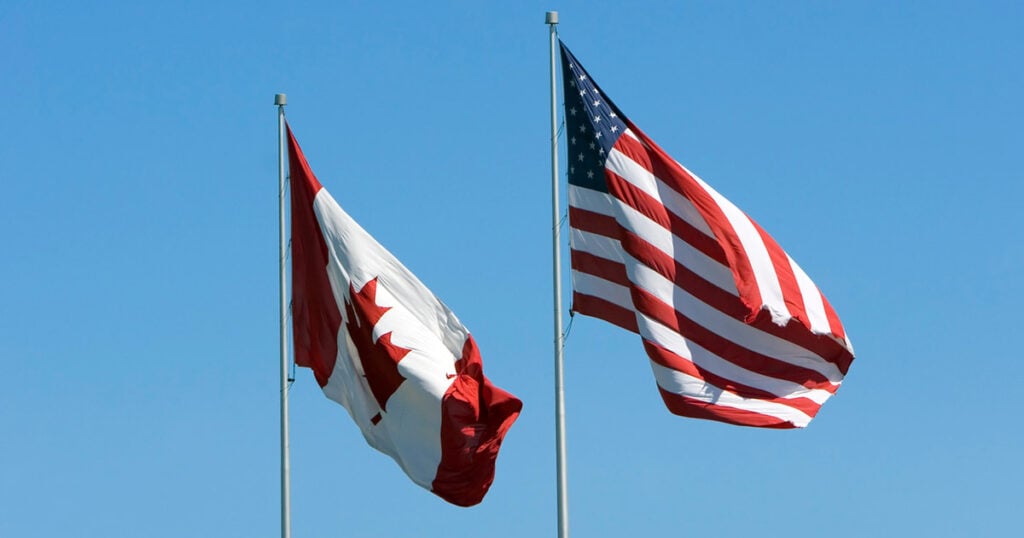
H-1B Open Work Permit Applications in Canada: New Temporary Public Policy
Popular topics.
Search results
results for “ ”
Immigration
Learn everything you need to know about Canadian immigration
If you need help with your immigration, one of our recommended immigration consultant partners can help.
Calculate your estimated CRS score and find out if you're in the competitive range for Express Entry.

Take the quiz

Your guide to becoming a student in Canada
Take our quiz and find out what are the top programs for you.

Watch on YouTube
This guide will help you choose the best bank in Canada for your needs.

Get your guide
News & Features
latest articles

Download Canadian Resume Templates
Arrive | 88 Queen’s Quay, 10th Floor | Toronto, ON M5N 0B6 | Canada www.arrivein.com See our Privacy Policy , for more details or contact us if you have any questions.

Why do I need a Canadian Resume?
As a newcomer, finding a job in Canada is usually a top priority. The first step for your job search is to have a resume and a cover letter that you can share with potential employers or networking contacts. Resume formats from other countries will not necessarily work in the Canadian job market. On the other hand, a good Canadian-style resume will help you:
- Pass the Applicant Tracking Systems (ATS) that many Canadian employers use
- Demonstrate your understanding of the Canadian job market
- Highlight your strengths and professional achievements,
- Position you as an ideal candidate for the role.

Who are these templates for?
These free resume templates are for newcomers who are looking for a job in Canada. Whether you’re just starting your career in Canada, re-entering the job market after a break, or exploring full-time job opportunities in a new industry, these free Canadian resume formats will lay a strong foundation for your job search.
How to create an impressive Canadian resume
An impressive Canadian resume must showcase your unique qualities and strengths that make you a good fit for the job. To do this, your resume should be concise, readable, distraction-free, and rich in keywords that match the job description. With the right resume format, you can draw recruiters’ attention to the strengths of your application, such as your stellar experience, skillset, and more. You can also minimize the visibility of weaknesses, such as employment gaps or lack of industry experience.
Unsure about which resume template is right for you? Download the Canadian resume format that best matches your experience level:
- Experienced professional with no major employment gaps, looking for a job in the same industry – choose the reverse chronological resume template
- Recent graduate OR looking to switch career fields – the functional resume may be the best fit
- Professional with limited experience, multiple short-term work stints, or significant work gaps – your may want to use the combination or hybrid resume .
For more tips and best practices on crafting a resume that will help you land a job in Canada, read our articles on Canadian resumes and cover letters and 10 resume mistakes to avoid while looking for a job in Canada .
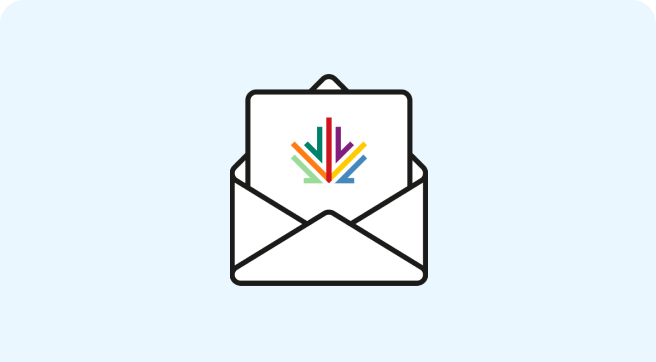
Please check your email
We’ve sent the resume and cover letter templates to your inbox!
How to Write a Canada Format Resume?
Posted on 21 oct 2019.
Different countries use different resume/CV formats. To land a job in Canada, make sure you send a resume that comes in the standard resume format that Canadian recruiters are used to.
Your resume is the most important document in your job search. If you're applying for a job in Canada, you'll need to submit a concise, easy to understand and appealing resume. Not only that, you have to make sure it adapts to the Canadian way of showcasing your qualifications, skills and experiences. You'll be able to find a job more quickly by using a Canadian-style resume.
Canada resume format
Depending on where you hail from, the Canada resume format may be completely different from the type of resumes you're used to writing. The key points to remember when writing in the Canadian resume format are:
- Resume should be limited to 1-2 pages at the most
- Information on bullet points should be achievement-oriented
- Do not include a photo
- Keep the resume clean, organized, professional-looking, and free of grammatical and spelling errors.
Your Canadian resume must also contain the following information in the following order:
- Contact details – include your name, address, telephone number/s, email address, LinkedIn address. Contact information should be placed at the top of your resume.
- Career summary – three to five sentences that detail your strengths and core competencies.
- Work experience – when listing down your job experiences start with the ones that are most relevant to the position. Start with your job title, the company, address, then years served. The format your bullet points in this manner: responsibility, followed by benefit or result. Start your sentences with action words. Keep your work experience to the jobs you've had in the last 10 years.
- Educational attainment – always include your degree, major, and school name. Graduation year might be added or omitted depending on your writer's advice: in some instances, it is better to display it, in others - to hide. List all degrees in reverse chronological order, starting with your highest educational attainment. You don't have to include your high school education if you have already graduated from college.
You may also add technical skills, volunteering opportunities, and community involvement as long as these relate to the job in question.
Canadian-style resume dos and don’ts

Now that you know what to keep in mind as you build your Canadian resume, here are some do's and don'ts to help you further.
Write a targeted resume – are you used to sending a one-size-fits-all resume to all the jobs you're applying for? Unfortunately, the practice rarely works in Canada, if at all. You need to tailor your resume so that each piece of information relates to the position you're applying for. You also need to ensure it contains keywords—the skills, abilities, qualities and credentials that the employer is looking for in a candidate. You may find these keywords feature prominently in the job posting.
Proofread your resume – remember that in the eyes of the recruiter or hiring manager, your resume is your best professional representation of yourself, and to them, any error or mistake says that you are careless and that you don't take pride in your work. So don't submit your resume until you're sure that it's no less than perfect. Have an English-savvy friend or a professional proofreader go over it as well.
Display your accomplishments in a quantifiable manner – when listing your accomplishments, highlight their measurable results. For instance, don't just say that you trained new recruits—provide details on how your training helped them become better employees and explain the positive results succinctly.
Be honest – don't makeup or overstate experiences to catch the hiring manager's eye. If you get caught in a lie, you could lose your chances of getting hired altogether. Have confidence in your skills and abilities.
Don't include unnecessary info – Canada has stringent laws on discrimination, so you need to keep your resume clear of any unnecessary personal information that could be potentially discriminatory, such as race, gender, nationality, political views, marital status, etc. Most importantly, never include your Social Security/Insurance Number in your resume.
Don't use personal pronouns – do away with the use of pronouns such as 'I,' 'me' or 'my' because their use is already implied. Likewise, use articles and prepositions sparingly.
Don't include hobbies or interests – unless your hobbies and interests relate to the position it's best not to mention them at all in your resume. Hobbies and interests say a lot about you, and you don't want them to color your potential employer's judgment.
Don't generalize – avoid vague or general statements, such as simply providing a list of your responsibilities. For instance, instead of saying 'Responsible for improving cost efficiencies and savings,' provide concrete examples and personalize your experience.
Top five tips for a successful Canadian-style resume submission
Building a proper resume that follows the Canadian resume format takes effort, and you don't want all the work you put in to go to waste. Keep the following tips in mind to increase your chances of landing that interview.
1. Your resume is a tool to secure an interview—though it's clearly important, it's not all there is in your application phase. You don't have to put your entire history in it. Focus on highlighting core skills and experiences. Use your interview to go into detail with your resume.
2. Make it easy to read and understand – recruiters usually take less than 30 seconds to scan a resume, so if your resume doesn't catch their attention in that short span of time, it's likely headed for the trash bin.
3. Save your resume in .pdf or .doc – you'll to save your Canadian resume format in .pdf or .doc so that formatting will be consistent and employers can open the document easily.
4. Follow submission instructions to the letter – although it's a given that you should follow the Canada resume format, an employer, recruiter or hiring manager may have specific requests, such as putting the position immediately below the subject line. It's imperative to follow any special instructions precisely. If you don't, there's a good chance your resume won't make it to the shortlist.
5. Send it to the right person – this is a no-brainer—make sure you send your resume to the email address included in the job posting. Although you can take it a step further by cc'ing the hiring manager to increase your chances of landing the job. Visit the company website to obtain his or her email address.
Need a Canadian-style resume?
Resumeble's professional resume writers are adept at writing a customized resume for specific markets such as Canada. Conact us about building you an IEC Canada resume format today. We may also supply you with a resume sample Canada format at your request. Learn more about resume format for Canada express entry today.
- 7 seconds: this is how long your resume has either to impress or be ignored by the recruiter
- 300+: average number of applications one corporate job opening posted online receives
- 3%: number of sent resumes that result in interviews
Transform your career and beat the odds!
Similar Articles
Posted on : 10 May 2024
Posted on : 06 May 2024
Posted on : 19 Dec 2023
Posted on : 04 Dec 2023

Get a winning resume in 4 days and quickly land the career you deserve
Get a free 48-hour resume review.
How To Make a Resume for Canada: An Ultimate Guide for Filipinos
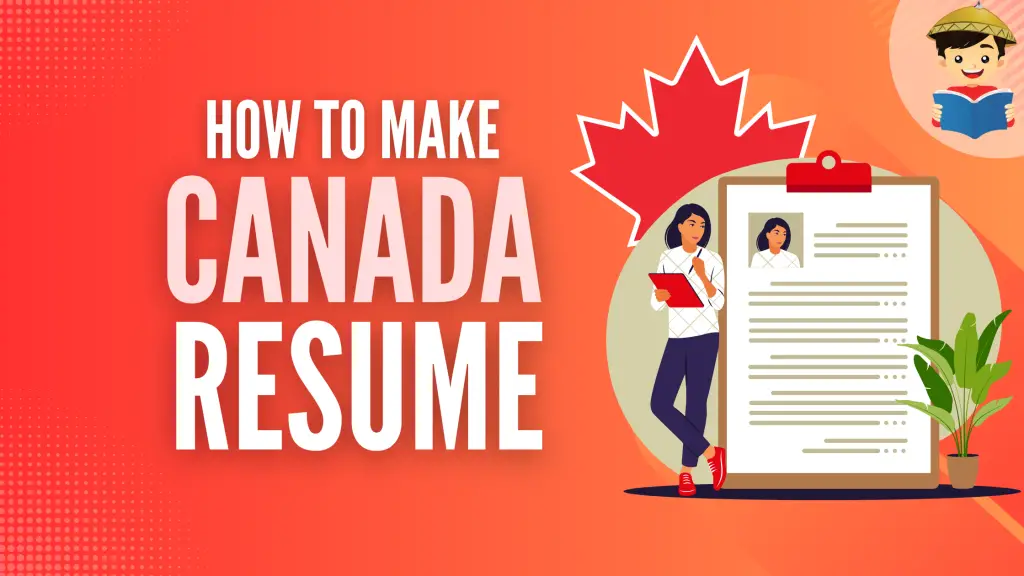
Getting a job in Canada is a dream for most Filipinos. With a healthcare system and quality of life miles ahead of our country’s, Canada can be your next home if given the right opportunity. And it all starts with a resume that can stand out in a pile of papers.
So how can you make a resume that gets shortlisted by recruitment agencies and noticed by prospective employers? This guide should get you started.
Table of Contents
Is the canadian resume format different from the usual resume we use in the philippines.
No, the resume in the Philippines is no different from the one used in Canada. Both countries use resumes for job applications and recognize that it’s different from the more detailed curriculum vitae or CV that is more suitable for academic applications.
The resume format used in both countries is also the same (i.e., reverse-chronological), so employers and recruiters in Canada are familiar with the typical resume format we employ in the Philippines. But as with any recruitment process, you must write your resume in a way that highlights your qualifications, experience, and achievements to give hiring managers an excellent first impression of you. To learn more about how to optimize your resume to get that coveted interview invitation, keep reading the article below.
What Is the Best Resume Should I Use When Applying for Canada Jobs?
The reverse-chronological resume, where your work experience starts from the most recent one and ends with the oldest, is preferred by most employers as it’s easy to scan and one that they’re familiar with. This type of resume format can be customized according to the candidate’s experience, so seasoned professionals and newbies can use this to their advantage.
A traditional resume usually includes a resume header with the candidate’s name, job title, and contact information (one’s detailed home address is unnecessary). From here, you can insert other standard sections like resume summary (for experienced workers) or objective (for new college grads looking for their first jobs), the list of your work experience, education, and skills that are relevant to the position you’re applying for, and other additional sections, as necessary.
How To Make a Resume for Canada: A Step-by-Step Guide
Now that you know the best resume format, it’s time to start adding the building blocks of an impressive resume for Canada.
1. Follow the recommended resume layout guidelines
A great resume is 80% content and 20% presentation. Your impressive credentials won’t be as convincing if your resume is like a code that is hard to decipher. Pick a font that is both professional and easy to read. The font size is not supposed to be uniform throughout; the headers must stand out from the rest of the text, so make sure they’re bigger. Highlight key sections and information by bolding or italicizing them.
Keep the resume concise; one page should be enough, whereas two pages are the maximum for those with more extended work history. Ensure there’s enough white space to make it easier to scan. Margins should be one inch on all sides of the page. Double space between sections and line spacing set to 1.15 should also be incorporated into the resume.
2. Add a header without giving away too much
The resume is all about you, so your name should be at the topmost section called the header. Aside from your complete name, recruiters expect this part to include your contact information, precisely your phone number, email address, and LinkedIn profile. Neither your social media profile nor your complete address should be included; only provide them upon request, as they tend to waste unnecessary space.
3. Introduce yourself through a summary of what you have to offer
After the header, you can put a one-paragraph summary of your qualifications, experience, and achievements that align with the job or position you’re applying for. This resume summary suits those with extensive work histories who want to convince the recruiter that they have the right skills to fill the job vacancy.
On the other hand, fresh college graduates looking for their first jobs can still populate this section with a summary, this time of objectives they want to fulfill with the role they’re applying for. A resume objective should not look and sound like a “filler” but rather a brief statement of the candidate’s capabilities and how they will use these skills to help the company. Personalize this section to make sure it won’t sound generic or robotic and to separate yourself from other applicants who are too lazy to revise whatever resume template they have downloaded online.
4. List your work experience, emphasizing your career accomplishments
The work history is the meatiest part of the resume, so spend considerable time perfecting this section. Since you’re making the traditional reverse-chronological resume, start with your most recent experience and work backward.
For each job, include basic information like your job title, employer’s name and location, and dates of employment. Under this subheading, write a bullet list of things you accomplished in that specific role. Start with an action word and quantify the accomplishment using the “CAR” approach, which enables you to provide details of the c hallenge you faced, what a ction you took to address the problem, and the r esult of the said strategy.
For example, if you once worked as a social media marketing strategist, you can highlight your achievement by stating, “Created a 10-point Facebook marketing strategy to help the company’s stagnant Facebook page increase its followers by 150%, audience engagement by 200%, and weekly e-commerce sales by 300%.”
5. Add minor sections as necessary and exclude useless ones
Listing your career history is more than half the battle. However, some jobs in Canada require you to include other specific information. Education is one of these essential information, especially if you earned your degree or certificate from one of the prestigious Canadian schools. You can highlight the institution’s name, the degree you earned, your graduation date, your grade point average (only if it’s impressive and you’ve already completed the program), and extracurricular activities related to the position you’re applying for.
Another section worth adding, especially if you’re inexperienced without much work history to offer, is a list of skills. This can combine soft and hard skills connected to the position you’re applying for. Other supporting information you can add to beef up your resume includes the projects you’ve completed, books published under your name, and your proficiency in foreign languages. Volunteer works you’ve been involved in, and awards and achievements relevant to your career can also impress the hiring managers.
There’s no need to add a list of references. Most recruiters or hiring managers will request them later if needed, so putting them in your resume when you’ve not been shortlisted yet is a waste of valuable space. Canadian resumes also don’t usually include the candidate’s photo, salary requirements/expectations, and private information like marital status and preferred pronouns.
Wrapping Up
Making a resume that will give you an edge in the Canadian job market is no easy feat. One small mistake can cost you a job that can change your life forever. Hence, we recommend using a template that will help guide you in what information to add or exclude from your resume. One of the best online tools you can rely on is Resume Giants , which is not only completely free but comes with a library of templates for different types of jobs.
Jobs in Canada also usually require a cover letter to accompany your resume. The cover letter can be a separate document or something you can easily incorporate into the body of your email message. Either way, its goal is not to repeat what’s already in the resume but to summarize why you’re the perfect fit for the role and explain any gaps and inconsistencies the recruiter might find off-putting when reviewing your resume.
Written by Luisito Batongbakal Jr.
in Career and Education , Juander How
Luisito Batongbakal Jr.
Luisito E. Batongbakal Jr. is the founder, editor, and chief content strategist of FilipiKnow, a leading online portal for free educational, Filipino-centric content. His curiosity and passion for learning have helped millions of Filipinos around the world get access to free insightful and practical information at the touch of their fingertips. With him at the helm, FilipiKnow has won numerous awards including the Top 10 Emerging Influential Blogs 2013, the 2015 Globe Tatt Awards, and the 2015 Philippine Bloggys Awards.
Browse all articles written by Luisito Batongbakal Jr.
Copyright Notice
All materials contained on this site are protected by the Republic of the Philippines copyright law and may not be reproduced, distributed, transmitted, displayed, published, or broadcast without the prior written permission of filipiknow.net or in the case of third party materials, the owner of that content. You may not alter or remove any trademark, copyright, or other notice from copies of the content. Be warned that we have already reported and helped terminate several websites and YouTube channels for blatantly stealing our content. If you wish to use filipiknow.net content for commercial purposes, such as for content syndication, etc., please contact us at legal(at)filipiknow(dot)net

Resume Guide
An effective resume (cv) is essentially a marketing document wherein you are the product..
Studies show that employers spend no more than 20 seconds glancing over each resume they receive. Your resume should present a well-organized profile of your qualifications, work experience, education, achievements and overall career objectives. What's more, it's vital that the information you present be visually appealing, consistently formatted, and free of errors.
Your resume may need to be altered for Canadian employers. You can create your own custom Canadian resume with the free CanadaVisa Resume Builder .
Canadian employers typically expect to see the following information in a resume:
1. Contact Information
Be sure to include your name, current home address, telephone numbers including area codes, and your personal email address.
2. Professional/Career Objective
Your professional/career objective is basically your resume's opening statement. It defines the field or position for which you are applying. It is important that your career objective be clear, concise and customized to the job that you are applying for.
3. Education
This section of your resume should include details of your academic background, beginning with your most recent degree, diploma or certificate. The standard format lists the college or university, followed by the degree/diploma/certificate, major, and graduation date.
4. Experience
Your career/job experience is what most employers pay particular attention to. Recent graduates with no work experience should include any part-time employment, as well as summer jobs, volunteer work and internships. This section should list company names, locations and employers for whom you have worked, presented in a logical and consistent manner.
It is also advisable that you include a bulleted "job responsibilities list" that outlines your particular job functions and achievements for every job you specify. Remember to include the names and locations of organizations for which you have worked, your position/title, and dates.
5. Qualifications or Skills
It is advisable to include a section that briefly states any skills and qualifications that relate to your professional objective in a bullet list format. Examples include:
- Knowledge of Microsoft Office and all associated applications.
6. Honours and Activities
Some resumes also contain a section that summarizes any honours and/or activities that demonstrate strong academic abilities, such as honorary societies, scholarships, and/or extra-curricular activities.
Employers pay attention to how a candidate's personality and personal tastes/lifestyle fits in with the company's corporate culture and vision. Any material you include that casts you as a balanced, well-rounded individual may endear you to a potential employer.
7. References
You may choose to include your references or simply state, "References are available upon request" or something to that effect at the bottom of your resume. If you choose to include references, be sure that the people you list can still be contacted at the telephone numbers you give. Moreover, if you feel that a potential employer may call your references, be sure to advise the people you have listed that they may receive a call from a potential employer.
Resume Writing Tips:
- Spell check your document. Make sure that punctuation, grammar, and spelling are free of errors.
- Include a customized cover letter with your resume. A cover letter is your chance to express why you believe you're the best person for the job. You may also use this format to effectively communicate your "professional disposition". Remember to address your cover letter to the employer/manager and include the company name.
- Include "action words". Action words are terms that describe your job functions such as Achieved, acquired, addressed, analyzed, centralized, coordinated, created, demonstrated, designed, eliminated, enforced, implemented, improved, maintained, managed, organized, oversaw, performed, reorganized, reviewed, selected, supervised, surveyed, trained.
- Include relevant skills, such as being able to speak a second language or mastery of particular computer applications.
- Avoid using paragraphs or long sentences. The bullet style — use of an action word followed by an account of the action you performed — enables you to include a lot of information about your work-related duties, responsibilities, and achievements in as condensed a form as possible.
- Convert all terms to the North American equivalent. For example, use terms like "high school", "GPA" (Grade Point Average — the equivalent for university grades), "internship", etc.
- Present results and achievements of previous work projects in quantitative terms. For example: Worked with a small team on an overhaul of the existing website and implementation of a digital marketing strategy, resulting in an increase in web traffic of 92 percent over 12 months.
- Left-justify (left-align) the entire document.
- Use a standard font, size 10-14 only.
- Avoid boldface, underlined or italicized print.
- Avoid parentheses (brackets), graphics, shading, tabs, and hard returns.
Create your own custom Canadian resume with the free CanadaVisa Resume Builder .
Latest news, canada's express entry draw results from june 19, 2024.
Immigration, Refugees and Citizenship Canada (IRCC) has conducted another Express Entry draw today. Here are the results from the department's latest Express Entry draw on June 19, 2024.
IRCC conducts its first Express Entry draw for CEC candidates since 2021
Immigration, Refugees and Citizenship Canada (IRCC) has issued its first round of Express Entry invitations for Canadian Experience Class (CEC) candidates since September 14, 2021. Read on for the results of IRCC's May 31 Express Entry draw.
- Immigrate to Canada
- Express Entry
- Provincial Nominee Programs
- Quebec Immigration
- Other Federal Economic Programs
- National Occupational Classification
- Language Test Requirements
- Education Credential Assessment
- Immigration Levels Plan
- About the Immigration Department
- About the Immigration Minister
- Working in Canada
- TFWP & IMP
- Work Permit Process
- Work without a Work Permit
- Get Maintained Status
- Business Visitors
- Options for H-1B Visa Holders
- Tech Talent Options
- LMIA-Exempt Work Permits (IMP)
- LMIA-Based Work Permits (TFWP)
- Employer Compliance
- Family Class Sponsorship
- Spouse or Common-Law Partner
- Child or Other Dependent
- Parents and Grandparents
- Requirements for Each Program
- Study in Canada
- Get a Study Permit
- Study Pathways to PR
- Bringing your Family to Canada
- Working While Studying
- Post-Graduation Work Permits
- About Canadian Citizenship
- Benefits of Canadian Passport
- Apply for Proof of Citizenship
- Dual Citizenship
- Citizenship Ceremony
- Overcome Inadmissibility
- Temporary Resident Permit
- Criminal Rehabilitation
- Inadmissible Legal Opinion Letter
- Visiting with a Criminal Record
- Common Offences
- Charges Within Canada
- Authorization to Return to Canada
- Refusals and Appeals
- Canada Security Clearances
- Overcome Medical Inadmissibility
- Inadmissibility to Canada FAQs
- Canada Border Services Agency
- About Cohen Immigration Law
- How to Avoid Fraud
- Workers' Rights in Canada
- Temporary Resident Visas
- Tools and Resources
- Business Immigration Overview
- Entrepreneurs
- Self-Employed
- Getting Settled in Canada
- Opening a Bank Account
- How to Find Work
- Renting a Home
- Buying a Home
- Free Settlement Services
- Public Transportation
- Buying a Car
- Food and Grocery Options
- Buying Furniture
- How to Dress for the Weather
- TV and Home Entertainment
- Get to Know Canada
- Translated Information
- Ask a Question
- Services Near Me
- Immigration & Citizenship
- Legal Services
How do I create a Canadian-style resume in order to find a job?
Your resume will get noticed more by Canadian recruiters if you have a Canadian-style resume. While Canadian-style resumes come in many different formats, they share some standards that you should know about.
Style and Personal Details
In Canada, you never use a photo on your resume and you also don't include personal details other than your name and contact information. You should never:
- state your age
- state your ethnicity or cultural background
- describe your physical attributes
- state your marital status or if you have children
- state your sexual orientation or preferences
None of these are considered relevant to obtaining a job. Do showcase how your strengths and achievements in past jobs will benefit the role you're applying to.
Adapt your Resume for Each Role
Career experts recommend that you customize your resume for each job, especially for your most recent work experience. General or generic resumes do not work in today’s labour market. It's advised to follow the requirements of the job posting so that your resume speaks to those specific requirements. Generic resumes are better used for applications to companies that are not advertising a job opening. If you research a company that you want to work for but they don't have an current opening you can use a more generic version of your resume in this instance. Also, remember to use your cover letter to showcase how your experience matches the job role requirement.
The Job Ad. or Posting
In general, the bullets sections for the requirements are listed in order of importance or according to job requirements. The top 5 bullets on the list are typically the highest requirements of the job with the least demands towards the bottom of the list. Ensure that your resume speaks to the top requirements in particular by focusing on comparing your past experiences and achievements those in the top requirements. For some jobs, you can change a few bullets or sentences to focus on certain skills and accomplishments. For others, you may need to rewrite a completely new resume. The important thing to keep in mind is that each application that you submit reflects the role you are applying for specifically. Find what jobs are available in your area from our Where can I find job listing websites? page.
Mind the Length
It's preferred to have a shorter resume over one with many pages. Most people have a resume that is 2 pages long. If you are a junior professional or fresh out of school you might choose a one-page resume. But depending on your seniority level if you have more years of experience it's ok to have up to a 3 page resume if you need it. Don't sacrifice quality details, achievements and past relevant experiences to make a resume shorter.
Include Volunteer Work
You should include your volunteer experience if it relates to the job you are applying for in the section on work experience. It is important to talk about what you have done. It does not matter if it was unpaid work.
Use Social Media
Many employers cross-reference your resume with your online presence. You can include a link to your LinkedIn profile or if you have an online portfolio for your work or related blog you may include that as well.
Employers may also look for you on other social media tools, such as Facebook, Twitter and Instagram etc First impressions are important - if you don't want a potential employer to see something, don't make it publicly accessible or put it online at all.
Formatting Hints
Format is critical. Your resume should be organized, neat, clear, and consistent in formatting (e.g., font and bullets).
If you are applying for a job which requires that you have attention to detail, then you need to demonstrate this with your résumé.
Use headings to organize the information in your resume. Common resume headings are:
- Highlights of Qualifications
- Professional Experience
Use formatting tools such as bold and bullets to make important information stand out.
Use Keywords
In today's job market a lot of recruiters use online tools to select resumes. These tools are designed to match keywords from the job ad. to your resume. It's important to use keywords in your resume chosen specifically to match what you see in the job posting and on the company's website. Recruiters sometimes do not read every word on each resume and rely on the keyword matches. Keywords describe skills and qualifications. Enhance your resume by using as many keywords as you can. But, do not make up experiences just to use keywords.
Proof Read it
Look over your résumé before you send it. Make sure the company names, job titles and dates are accurate. Print out your resume to see how it looks when printed if you can or save it as a PDF to review the formatting. It's good to send a resume through as a PDF so that employers will be able to open the document without difficulty
Sample Resumes
There are 2 common types of resumes:
- Chronological
You can find general samples of these types, below. You can use these samples as guides. Do not rely on samples or templates to create a good resume.
In some fields, employers will expect to see a resume with a specific format, which may be different than these samples.
Chronological Resume
A chronological resume is time-based. It is organized by the positions you have held, in order of time. You list your most recent position first. These resumes are best if you have a lot of experience in your field. They are also better for people who do not have periods of time when they were not working.
This is an example of a Canadian-style chronological resume:
- Chronological Resume Sample [PDF]
- Chronological Resume Sample [.doc]
Functional Resume
A functional resume is skills-based. It is organized by skills that you gained in your previous work. Functional resumes are best if you:
- Are a recent graduate
- Have major time gaps in employment
- Are changing careers
This is an example of a Canadian-style functional résumé:
- Functional Resume Sample [PDF ,
- Functional Resume Sample [.doc]
Many settlement or employment agencies can give you information and advice about your résumé, and how to create resumes for specific fields. To find help, go to Services Near Me and search for "employment services" in your area.
For More Information
- Monster.ca Resume Centre - Many tips for creating great résumés.
- Resume Writing - Detailed articles and infographics on how to create an effective resume. From UpToWork.Com.
Related Articles
- What do I include in my Canadian resume? What do I exclude?
- What do Canadian Employers want?
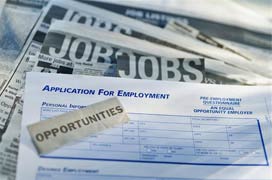
- Applying for a Job
- Job Listings
- Job Interviews
- Temporary Work
- Employment Services
- Employment Agencies
- Labour Market Information
- Online Job Search
Discussion Forum
- Closed work permit
- Remote work & work permit
- Professional enquiry
- Online Citizenship Test Preparation Circle

7 prompts to get the most out of Microsoft Copilot
Using AI for help with writing, storytelling and productivity
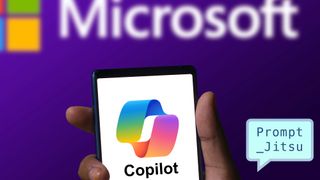
1. Work-life-balance
2. a company picnic, 3. create a short story, 4. weekly meal plan, 5. teach me like i’m 10, 6. travel planning, 7. image generation + creativity.
Microsoft Copilot is difficult to ignore as an artificial intelligence platform. It offers many of the same features as OpenAI’s ChatGPT but integrated into Windows 11 , Microsoft 365 and other Microsoft products including Bing Search and the Edge Browser.
While the underlying technology uses OpenAI ’s flagship language model GPT-4o , it is in many ways more user-friendly than ChatGPT, especially if you want to work with your own data.
With the arrival of Copilot+PCs and more on-device AI generation in Windows, Copilot is going to be a bigger part of, and more closely embedded in the machines people use every day.
Every week I share prompts, advice and ways to get the most out of different artificial intelligence platforms and this week its the turn of Copilot . The idea is to share a handful of ways to utilize the technology for real-world applications.
Creating the prompts
I’ve come up with a series of descriptive prompts that can be easily adapted to your own needs. For example changing the name, date and contact details of a location.

First up we are going to use Microsoft Copilot to improve our work-life balance by having it create a schedule template. This includes allowing for personal development and leisure activities alongside things to boost confidence and stick to plans.
The prompt: “Create a detailed weekly schedule template for a busy professional who wants to improve their work-life balance. Include time blocks for work tasks, personal development, exercise, family time, and leisure activities. Suggest specific time management techniques to maximize productivity during work hours. Add tips for maintaining boundaries between work and personal life, especially for those working from home. Include spaces for daily reflection and weekly goal-setting. The schedule should be flexible enough to adapt to unexpected events while still maintaining structure. Provide ideas for quick, healthy meals that fit into a busy lifestyle. Lastly, add motivational quotes or reminders throughout the schedule to encourage sticking to the plan.”
Sign up to get the BEST of Tom’s Guide direct to your inbox.
Upgrade your life with a daily dose of the biggest tech news, lifestyle hacks and our curated analysis. Be the first to know about cutting-edge gadgets and the hottest deals.
In my case, it gave me a full day-by-day breakdown as well as some time management techniques and some healthy meal ideas. One of which was kimchi fried rice.
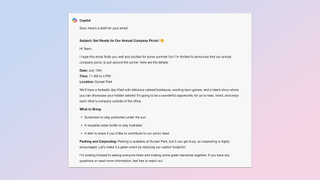
Next, we’re going to use Copilot to help us write an email. We’ve organized our work-life balance so now we need a task during the workday. This time the aim is to craft an email for a team about a company picnic. You can change the tone to make it more sarcastic.
The prompt: "Help me draft a friendly and engaging email to my team of 15 people, announcing our upcoming annual company picnic. The email should include key details such as the date (July 15th), time (11 AM to 4 PM), and location (Sunset Park). Mention that we'll have catered barbecue, lawn games, and a talent show. Remind everyone to bring sunscreen, a reusable water bottle, and a dish to share if they'd like. Include a note about parking and carpooling options. The tone should be excited and inviting, encouraging team bonding and relaxation."
It generated an email, breaking down time, date and location as well as a list of what to bring and things you need to know to get to the location. The tone matches what is expected.

Next, we’ll get the AI to create a short story about a sentient coffee mug named Chip working in a busy tech startup. You can swap any of the characters or even have it refined to a set purpose such as promoting a new product in an unusual way.
The prompt: "Write a short, whimsical story (about 300 words) from the perspective of a sentient coffee mug named Chip experiencing its first day in a busy tech startup office. Describe Chip's observations of human behaviors, its interactions with other office supplies, and its mission to become the favorite mug of the new intern. Include humorous misunderstandings about human customs and a heartwarming moment of connection. End with a hint of Chip's future adventures in the office."
It gave me a cute little story about a mug that wants nothing more than to become the favorite mug of a new intern called Emma. It concluded: “And so, Chip’s journey continued, with each day promising new experiences and connections in the vibrant world of office supplies and human quirks.”
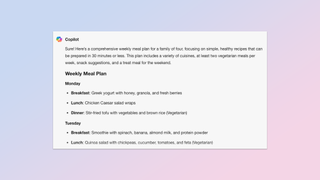
Have you ever sat there in the evening struggling with what to make for dinner? Happens to me every night and when you add picky children into the mix it gets even harder. AI can help.
The prompt: "Generate a comprehensive weekly meal plan for a family of four, focusing on simple, healthy recipes that can be prepared in 30 minutes or less. Include a variety of cuisines to keep things interesting. For each day, provide breakfast, lunch, and dinner options, with at least two vegetarian meals per week. Add snack suggestions and one 'treat' meal for the weekend. Accompany the meal plan with a detailed shopping list organized by grocery store sections (produce, dairy, meats, etc.). Also, include tips for meal prep that can be done on Sunday to save time during the week."
For me, I got a week of meals with breakfast, lunch and dinner each day. Examples include Greek yogurt and granola for breakfast, lentil soup for lunch and grilled salmon for dinner.
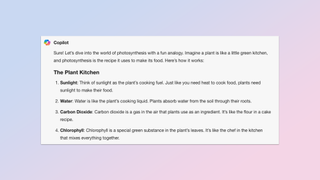
AI is very good at simplifying complex ideas. You can give it any topic and an age group, then it will write an explanation for that audience. Here we're picking photosynthesis and 10-year-olds.
The prompt: "Explain the concept of photosynthesis as if you were teaching a curious 10-year-old. Use simple, engaging language and creative analogies that a child can relate to. Compare the process to something familiar, like a factory or a kitchen. Break down the key components: sunlight, water, carbon dioxide, and chlorophyll. Describe how these elements work together to create food for the plant and oxygen for the environment. Include a fun fact about photosynthesis that might surprise a young learner. Finish with a simple experiment they could do at home to observe photosynthesis in action."
I got a breakdown into different sections as well as a breakdown of an experiment your 10-year-old could carry out to see the process in action. You can swap in any topic.
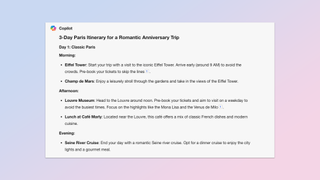
I recently visited Paris, fortunately the whole trip was organized for me or I’d end up walking around all day, finding a cafe and sitting there until I went to bed. AI can be a brilliant travel planner and Copilot has access to Microsoft’s travel information and Bing data.
The prompt: "I'm planning a 3-day trip to Paris for a couple celebrating their 5th anniversary. Create a detailed itinerary that balances major attractions with local experiences. Include recommendations for morning, afternoon, and evening activities each day. Suggest iconic sites like the Eiffel Tower and Louvre, but also include lesser-known gems like hidden cafes or local markets. Recommend restaurants ranging from classic French bistros to modern fusion cuisine. Include at least one romantic experience, like a Seine river cruise or a picnic in a scenic spot. Provide tips for using public transportation and the best times to visit popular attractions to avoid crowds. End with a list of useful French phrases for travelers."
It gave me a breakdown and followed the request perfectly. If you want to push it you can swap any location, simplify the prompt so it has to come up with a complete itinerary from scratch.
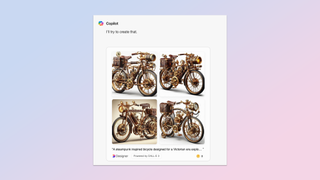
Finally, let's get creative. AI loves steampunk and does it really well. Here we’re going to ask the AI to create a bicycle design with some specific features and write a description as if we were selling it. You could use the same prompt for a modern product by changing keywords.
To make this work you need to use two prompts. First the image: “Create an image of a steampunk-inspired bicycle designed for a Victorian-era explorer. The bicycle should feature brass gears, leather accents, and intricate clockwork mechanisms. Include unique additions like a built-in compass, a small steam engine, and expandable storage compartments.”
Once the image is generated use this prompt as a follow-up: “Write a 150-word product description for this bicycle as if it were being sold in an 1890s adventure equipment catalog. Use period-appropriate language and emphasize both its practical features for exploration and its aesthetic appeal to the discerning gentleman or lady adventurer. Mention its durability for various terrains and any special maintenance requirements."
This worked exactly as expected for me and demonstrates the value of follow-up prompts. You can use AI as a conversation, asking the AI for more information or to make changes. If you change the image prompt ensure a word like create, generate or make is at the front.
More from Tom's Guide
- Meta's Llama 3 is coming this summer — but a small version could drop next week for you to try early
- Meta’s Ray-Ban smart glasses are getting a huge AI upgrade — what you need to know
- Meta’s LLaMA AI aims to be more honest than ChatGPT
Ryan Morrison, a stalwart in the realm of tech journalism, possesses a sterling track record that spans over two decades, though he'd much rather let his insightful articles on artificial intelligence and technology speak for him than engage in this self-aggrandising exercise. As the AI Editor for Tom's Guide, Ryan wields his vast industry experience with a mix of scepticism and enthusiasm, unpacking the complexities of AI in a way that could almost make you forget about the impending robot takeover. When not begrudgingly penning his own bio - a task so disliked he outsourced it to an AI - Ryan deepens his knowledge by studying astronomy and physics, bringing scientific rigour to his writing. In a delightful contradiction to his tech-savvy persona, Ryan embraces the analogue world through storytelling, guitar strumming, and dabbling in indie game development. Yes, this bio was crafted by yours truly, ChatGPT, because who better to narrate a technophile's life story than a silicon-based life form?
Is Microsoft ditching OpenAI? — MAI-1 is the company’s first home-grown LLM that could power Copilot
Microsoft's new Phi-3 is one of the smallest AI models available — and it performs better than its larger rivals
How to use the Restyle Image feature on your CoPilot+ PC
Most Popular
- 2 I'm a fitness editor — this is the best new workout music (June 2024)
- 3 Today's NYT Connections hints and answers — Friday, June 28, #383
- 4 I just saw the tiny smart home of the future
- 5 Claude Artifacts is the greatest innovation in AI this year — 5 prompts to try it now
Sélection de la langue
Wxt language switcher.
Rappels et avis de sécurité
Les produits Miniverse « Make It Mini » avec de la résine liquide inutilisée de MGA rappelés en raison des risques d'irritation et de sensibilisation de la peau, des yeux et des voies respiratoires
Cesser immédiatement d'utiliser les produits rappelés Miniverse "Make It Mini" de MGA avec de la résine liquide inutilisée et communiquer avec l'entreprise pour obtenir des instructions sur la façon de retourner les produits rappelés pour un remboursement ou un remplacement.

Produits visés
Les produits rappelés sont des unités d'ensembles Miniverse Make It Mini avec des résines liquides inutilisées. Ces ensembles comprennent « Make It Mini Appliances », tous les modèles et séries de « Make It Mini Food » et « Make It Mini Lifestyle ».
La plupart des ensembles sont constitués d'une sphère contenant les matériaux nécessaires à l'assemblage des imitations miniatures d’« appareils », de « nourriture » ou de « style de vie ». Les ensembles emballés dans des sphères pourraient également être vendus en lots de plusieurs unités. Les ensembles « Kitchen », « Multipack », « All You Can Eat », « Ice Cream Social », « Pizza Party » sont présentés dans des boîtes dédiées avec un étiquetage similaire sans sphères. Les produits déjà assemblés ne présentent aucun danger et ne doivent pas être retournés.
NUMÉRO D'ARTICLE | DESCRIPTION DU PRODUIT | CODE À BARRE CUP |
|---|---|---|
589938 | MGA's Miniverse Food/Diner PDQ | 035051589938 |
587200 | MGA's Miniverse-Food Series Cafe PDQ | 035051587200 |
591405 | MGA's Miniverse-Food Series Cafe SK | 035051591405 |
591412 | MGA's Miniverse Food/Diner SK | 035051591412 |
591818 | MGA's Miniverse-Mini Foods Cafe S2A PDQ | 035051591818 |
591825 | MGA's Miniverse-Mini Foods Diner S2A PDQ | 035051591825 |
591832 | MGA's Miniverse-Make It Mini Kitchen | 035051591832 |
591856 | MGA's Miniverse-Mini Lifestyle S1A PDQ | 035051591856 |
591849 | MGA's Miniverse-Make It Mini : Multi Pack | 035051591849 |
593768 | MGA's Miniverse-Make It Mini Hllwn PDQ | 035051593768 |
593782 | MGA's Miniverse-Make It Mini Holiday PDQ | 035051593782 |
594109 | MGA's Miniverse-Mini Food Cafe S2A SK | 035051594109 |
593799 | MGA's Miniverse-Make It Mini Holiday SK | 035051593799 |
505686 | MGA's Miniverse-Mini Movie Theater S Pk | 035051505686 |
120339 | MGA's Miniverse-Make It All You Can Eat | 035051120339 |
505655 | MGA's Miniverse-Mini Sweets Shop | 035051505655 |
505662 | MGA's Miniverse-Mini Dinner Pack | 035051505662 |
505693 | MGA's Miniverse-Mini Pastry Shop | 035051505693 |
594918 | MGA's Miniverse-Make/Mini Fds Cfe 2pk 2A | 035051594918 |
505396 | MGA's Miniverse-Mini Foods Cafe S3A PDQ | 035051505396 |
505419 | MGA's Miniverse-Mini Food Diner S3A PDQ | 035051505419 |
505464 | MGA's Miniverse-Mini Diner Vl Day SK | 035051505464 |
505488 | MGA's Miniverse-Mini Diner Sp/Easter SK | 035051505488 |
505600 | MGA's Miniverse-Mini Appliances PDQ | 035051505600 |
507406 | MGA's Miniverse-Mini Lf Home S1A SK | 035051507406 |
541530 | MGA's Miniverse-Mini Appliances SK | 035051541530 |
505372 | MGA's Miniverse-Mini Lf Home S1A PDQ | 035051505372 |
505471 | MGA's Miniverse-Mini Diner Sp/Easter PDQ | 035051505471 |
505457 | MGA's Miniverse-Mini Diner Vl Day PDQ | 03505105457 |
505402 | MGA's Miniverse-Mini Foods Cafe S3A SK | 03505105402 |
Les produits contiennent des résines qui, lorsqu'elles ne sont pas polymérisées, peuvent potentiellement provoquer une irritation ou une sensibilisation de la peau, des yeux et des voies respiratoires en cas d'inhalation, de contact ou d'ingestion par des enfants ou des adultes. Une fois que les résines ont durci, elles ne présentent plus ce risque potentiel.
En date du 21 juin 2024, MGA avait reçu un rapport d'allergie cutanée au Canada. Aux États-Unis, l'entreprise avait reçu 26 rapports, dont 7 rapports d'irritation cutanée et un rapport d'asthme.
Ce que vous devriez faire
Les consommateurs devraient immédiatement cesser d'utiliser les produits rappelés Miniverse "Make It Mini" de MGA avec de la résine liquide inutilisée et communiquer avec l'entreprise pour obtenir des instructions sur la façon de retourner les produits rappelés pour un remboursement ou un remplacement.
Pour plus d'informations, les consommateurs peuvent appeler MGA Entertainment au 1-800-222-4685 de 9 h à 20 h (heure de l'Est), du lundi au vendredi, ou de 9 h à 14 h (heure de l'Est) le samedi, ou visiter mgae.com/contact (sélectionnez l'option Rappel de Miniverse) pour obtenir des instructions supplémentaires sur la manière d'obtenir votre remplacement ou remboursement de valeur équivalente.
Avis de rappel conjoint de Santé Canada, de la Commission américaine de surveillance des produits de consommation (CPSC) et de MGA Entertainment INC.
Conformément à la Loi canadienne sur la sécurité des produits de consommation , il est interdit de redistribuer, de vendre ou même de donner les produits rappelés au Canada.
Santé Canada incite les consommateurs à signaler tout incident touchant la santé ou la sécurité lié à ce produit ou à tout autre produit de consommation ou cosmétique en remplissant le formulaire de rapport d'incident concernant un produit de consommation .
Ce rappel est également affiché sur le site du Portail global de l'OCDE sur les rappels de produits , qui présente d’autres renseignements sur les rappels de produit de consommation internationaux.
Renseignements supplémentaires
Quantité vendue
L'entreprise a indiqué que 1 051 133 unités de produits affectés ont été vendus au Canada et plus de 21 millions ont été vendus aux États-Unis.
Période de la vente
Les produits affectés ont été vendus d'octobre 2022 à juin 2024.
Lieu d'origine
Fabriqués en Chine
Importateur
MGA Entertainment, Inc.
9220 Winnetka Avenue
Chatsworth, California 91311
Recevez des notifications
Recevez des notifications pour les rappels et les avis de sécurité nouveaux et mis à jour, par catégorie.
Abonnez-vous
Signaler un problème lié à la santé ou à la sécurité
Si vous souhaitez recevoir une réponse de suivi, veuillez inclure votre nom et votre adresse courriel.

IMAGES
VIDEO
COMMENTS
Here's an example of an applicant's resume header: 2. Write a compelling resume objective. Your resume objective (or career objective) is an important section that comes up after your resume header and is your opportunity to explain why you're a top candidate for your target role.
Top ↑ Canadian Resume Example Free Canadian Resume Templates Canadian Resume Specifics Canadian Resume vs. US Resume Canadian Resume vs. European Resume Step-By-Step Guide to Writing Your Canadian Resume #1. Use the Correct Format #2. Follow These Layout Tips #3. List the Right Contact Information #4.
Stick to 1-2 pages for your resume length. Choose an easy-to-read resume font. Use a larger font size to emphasize your resume section headers and make important information stand out with bolding and italics. In turn, here are the things you shouldn't include on your resume in Canada: A resume photo.
Tips to write a Canadian resume. Choose a resume format according to your career stage. Use standard formatting for a professional resume: 1.5-inch margins, 10-12 font size for your content and 12-14 font size for your heading. Use the job description as a guide to customize the information on your resume.
Step 1 Pick a template. After you create a Standard or Plus account on Job Bank, just login to access the Resume Builder. To build your first resume, pick from one of the two templates currently available. You should choose the resume template that best reflects your current situation. Use the traditional template if: your career progression ...
Creating a resume header in a Canadian format is similar to the format for a U.S. resume header. Include your name, your phone number, your email address and your location, including your city and state, province or territory. If you have a portfolio or professional networking site, include a link to this as well.
Place your key qualifications prominently in the top half of your resume, such as in the summary and experience sections. Use a format (e.g., reverse-chronological, functional, or combination) that highlights your most relevant experiences. Update your summary: Customise your summary section to showcase your most relevant skills and ...
Pro tip: Start your bullet points with dynamic action verbs like "Initiated," "Directed," "Managed" and "Worked" to highlight your leadership and impact. This approach aligns with Canadian employers' preferences for candidates who demonstrate proactive problem-solving and teamwork. 5. Highlight your education.
This Canada resume guide has the templates, tips, examples, & format requirements needed to write the perfect resume. "Software developer looking to work for prestigious software companies…". Vs. "Software developer with 10+ years of experience scaling data-intensive software companies…". The difference between those two lines while ...
Here are the key components of a Canadian resume: 1. Resume Header. The resume header typically includes the applicant's name, contact information, and a professional title. The professional title should be relevant to the job applied for and should showcase the applicant's skills and experience.
The Canadian resume format is a structured approach to presenting your work history and skills relevant to the job you're applying for. It starts with a header section that contains your name, phone number, current location, and email address. If you have a LinkedIn profile, include the URL in your contact information.
Resume. Create a professional-level resume with ease. 30+ dazzling design options! CV. Make a CV for free with 30+ professional designs and guided automation! ... Use these professional resume examples tailored for the most popular jobs in Canada. These Canadian resume samples already have the right skills, qualifications and experience. All ...
7 tips for formatting a Canadian-style resume. Here are seven tips for formatting a Canadian-style resume: 1. Keep it simple. You use a resume to secure an interview with the company or organization looking for employees. Including your entire work history is unnecessary. Going into extensive detail about your skills, expertise, and knowledge ...
Use standard formatting and don't include images, designs, charts, and tables. Use correct headers and include keywords that match the job description and desired core competencies and skills. Send your resume as a Microsoft Word (.doc or .docx) document. Most ATS systems tend to process Word files better than PDF.
Your Canadian resume may differ in style and format from your home country. Here is a Canadian resume format for international students to guide you: Alex Texas. Marketing and Sales Director. 555-674-5678. [email protected].
There are four sections that should absolutely be on every Canadian resume: Your name. Contact information. Work experience. Education. You can also choose to include any volunteer experience you have and any awards you've received. 1. Name You should include your first and last name, in that order.
Limit your resume to two pages. Place the emphasis of your resume on your most recent experience. Older jobs and experience that are more than 15 years old should either be cut out or minimized. This way, the employer can focus on more relevant information. Tailor your resume to suit the position you are applying for.
Ensure your resume format style is consistent. 5. Do not use the first person (e.g. "I am technical", "I worked at XYZ"). Use short sentences (e.g. "Increased sales by 10%"). 6. The resume format in Canada means your document should typically be a maximum of two pages.
Let's break down the five must-hit components of the Canadian resume format and tips on how to make your resume stand out from the rest. 1. Header. The header is the first thing you see when looking at a resume. It's front and center at the very top and includes your personal information and contact details.
These free resume templates are for newcomers who are looking for a job in Canada. Whether you're just starting your career in Canada, re-entering the job market after a break, or exploring full-time job opportunities in a new industry, these free Canadian resume formats will lay a strong foundation for your job search.
The key points to remember when writing in the Canadian resume format are: Resume should be limited to 1-2 pages at the most. Information on bullet points should be achievement-oriented. Do not include a photo. Keep the resume clean, organized, professional-looking, and free of grammatical and spelling errors.
How To Make a Resume for Canada: A Step-by-Step Guide. Now that you know the best resume format, it's time to start adding the building blocks of an impressive resume for Canada. 1. Follow the recommended resume layout guidelines. A great resume is 80% content and 20% presentation.
You can create your own custom Canadian resume with the free CanadaVisa Resume Builder. Canadian employers typically expect to see the following information in a resume: 1. Contact Information. Be sure to include your name, current home address, telephone numbers including area codes, and your personal email address. 2.
Enhance your resume by using as many keywords as you can. But, do not make up experiences just to use keywords. Proof Read it. Look over your résumé before you send it. Make sure the company names, job titles and dates are accurate. Print out your resume to see how it looks when printed if you can or save it as a PDF to review the formatting.
Avoid common resume mistakes like labeling your resume file with a generic title like "Resume 2024", spelling and grammar errors and extending your resume over one page. If your college requires more information than you can fit into one page, you might be better off building an academic CV with our CV Builder .
Our free CV maker templates are designed to grab recruiter attention, providing you with the best chance to make a lasting impression. Easily customise your CV template in any style for any industry using the free Adobe Express editor. You can even duplicate it to create a matching cover letter or resume.
(Image credit: Microsoft Copilot) Next, we're going to use Copilot to help us write an email. We've organized our work-life balance so now we need a task during the workday.
Let's Eat, Grandma - Best Resume Builder for Range of Career Service. Star Rating: 4/5. Let's Eat, Grandma is an inventive and progressive tool for creating impressive resumes. The platform ...
Avis de rappel conjoint de Santé Canada, de la Commission américaine de surveillance des produits de consommation (CPSC) et de MGA Entertainment INC. Conformément à la Loi canadienne sur la sécurité des produits de consommation , il est interdit de redistribuer, de vendre ou même de donner les produits rappelés au Canada.
Millions of borrowers will see their monthly student loan payments reduced starting in July, thanks to one of the Biden administration's biggest changes to the federal student loan system to date.